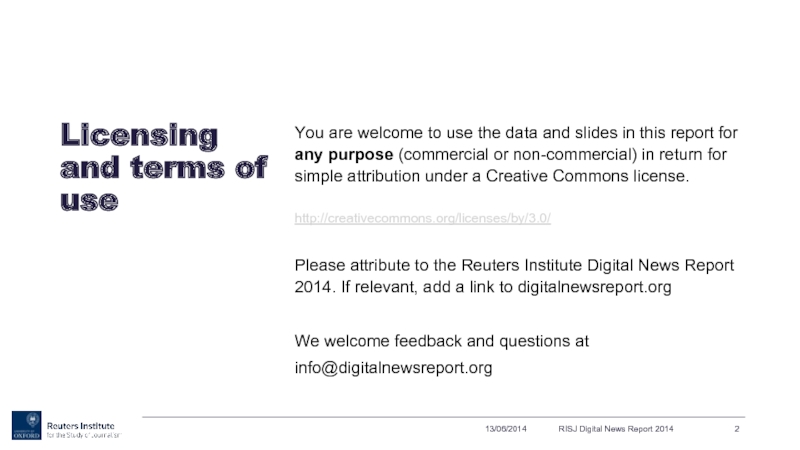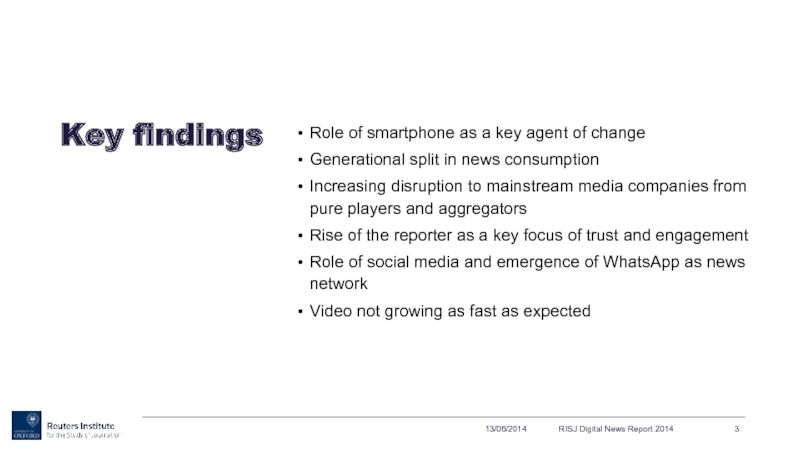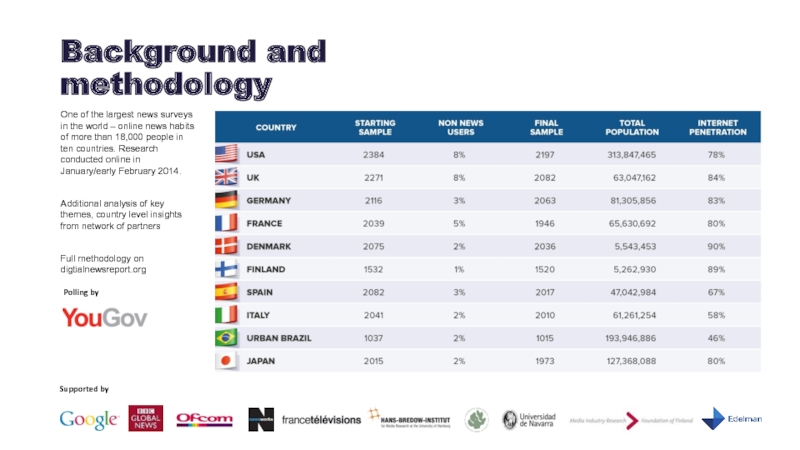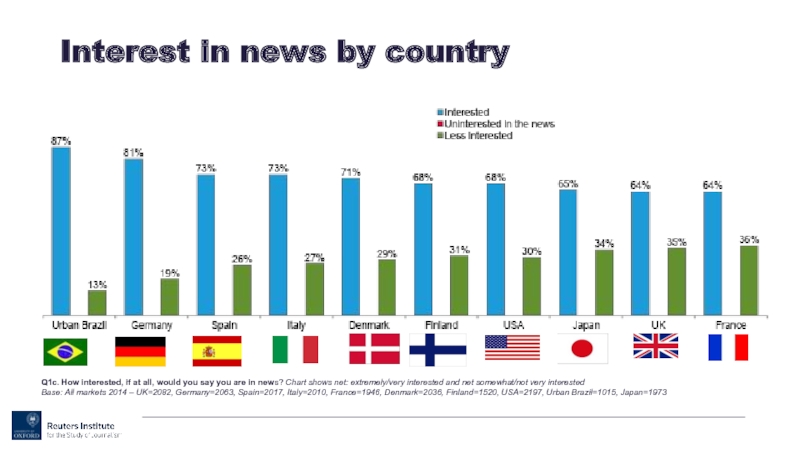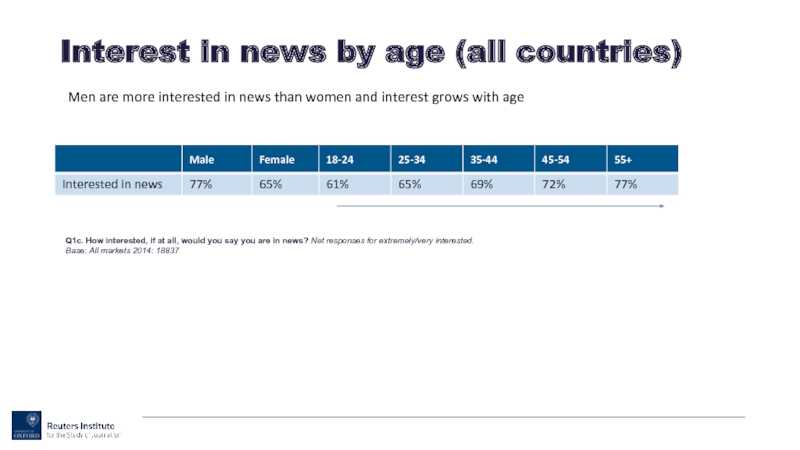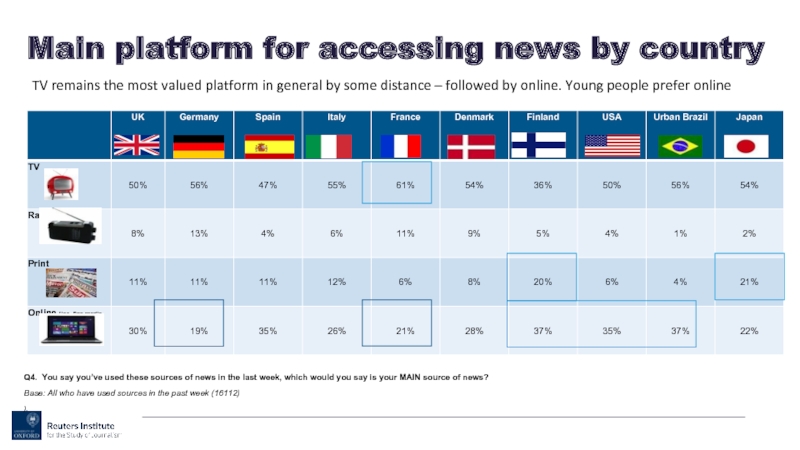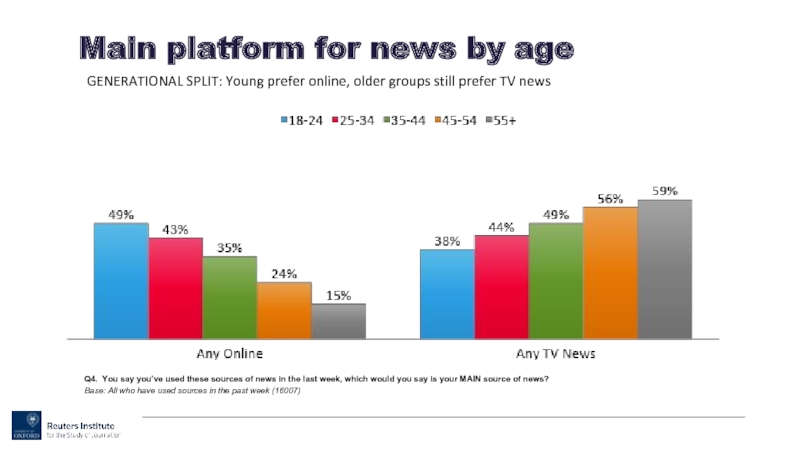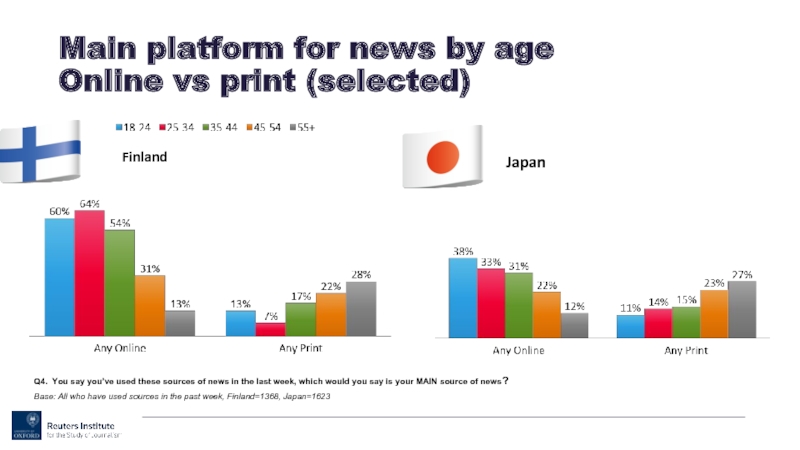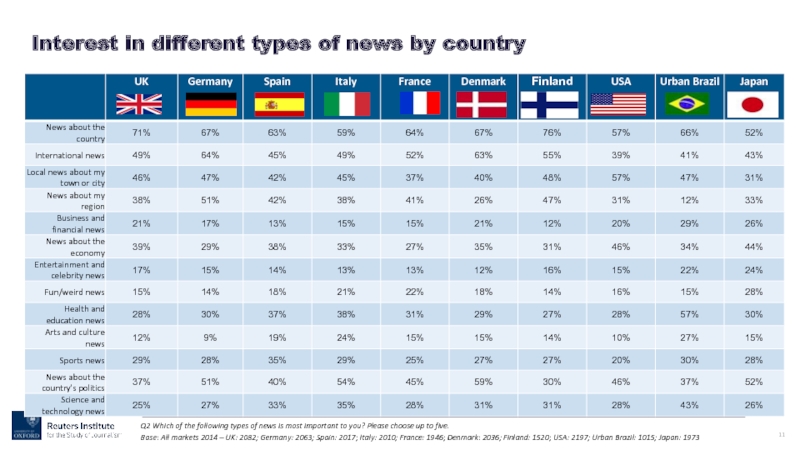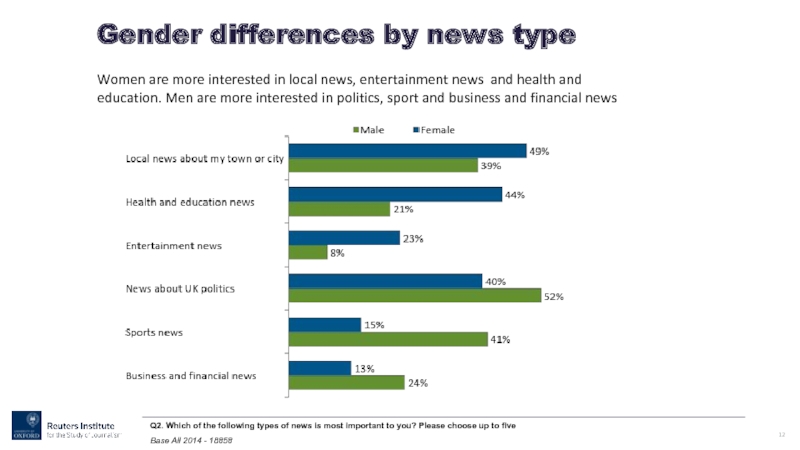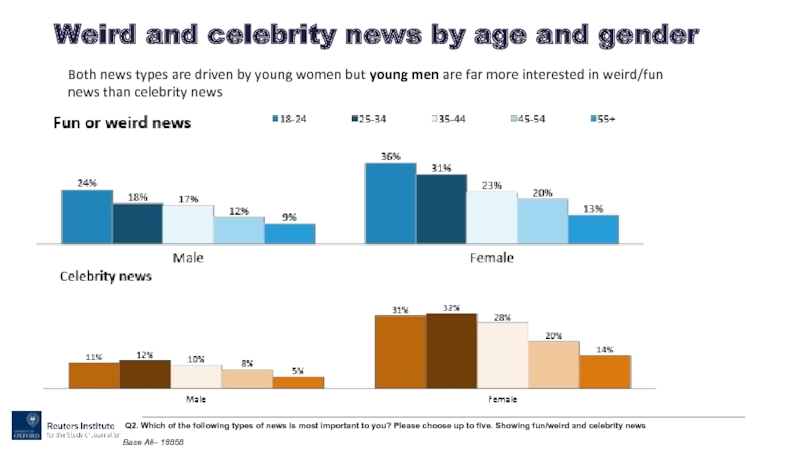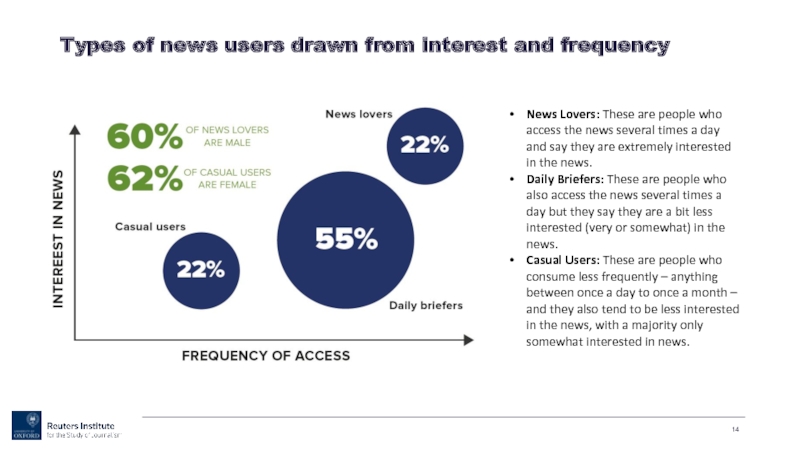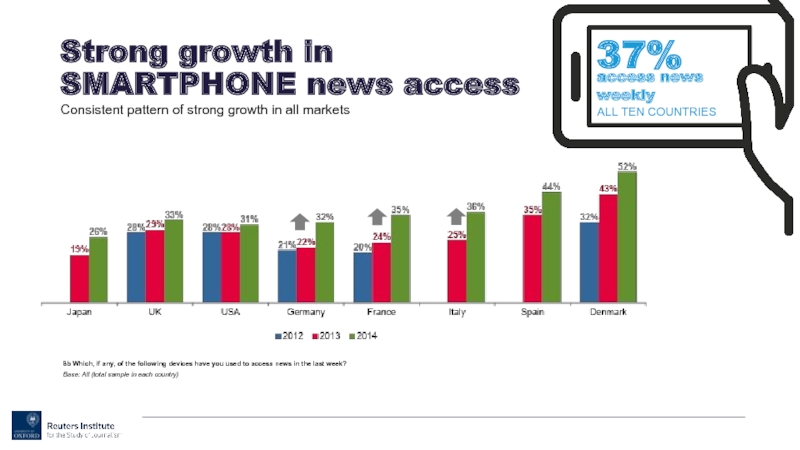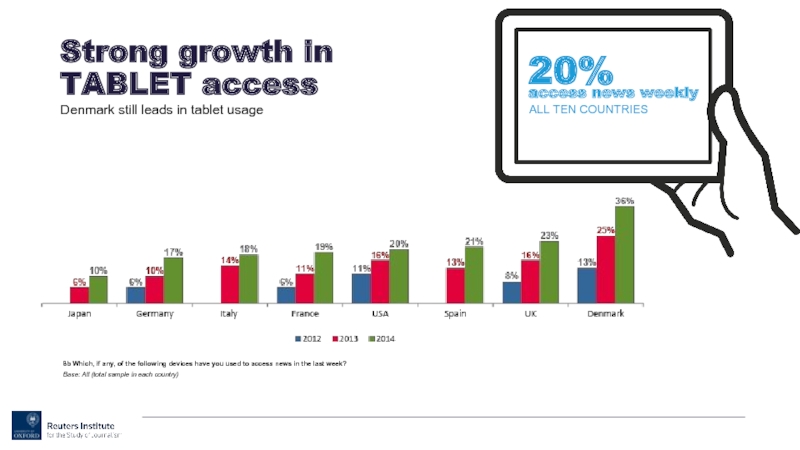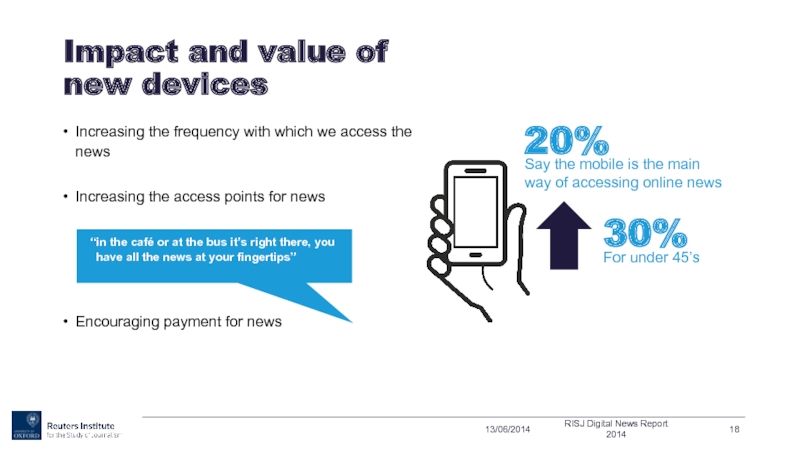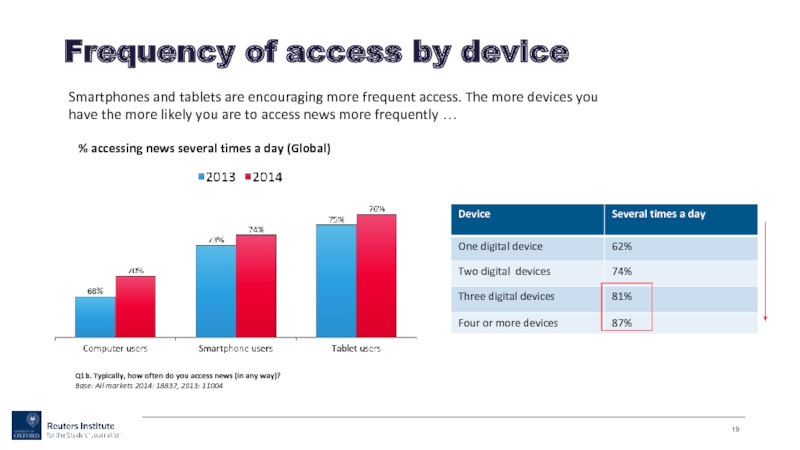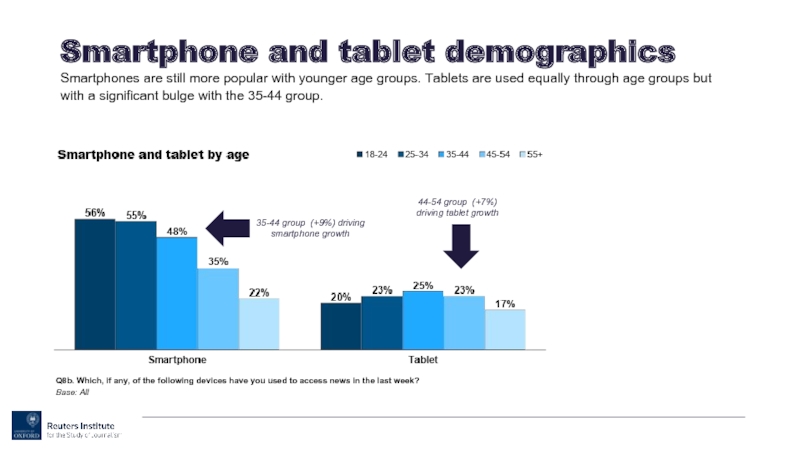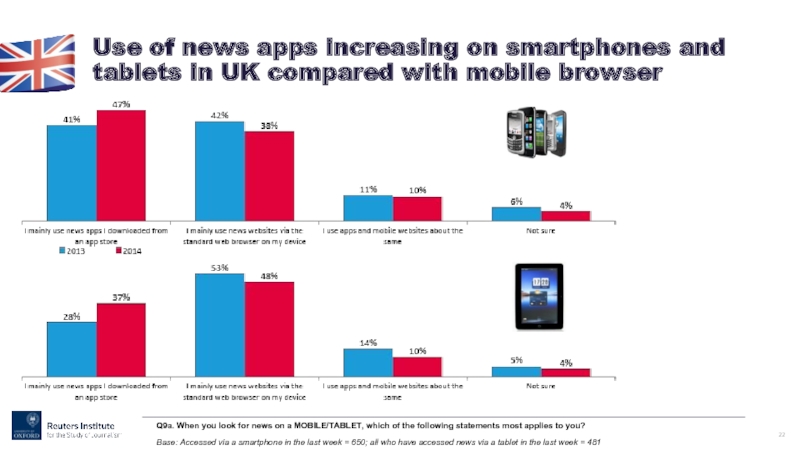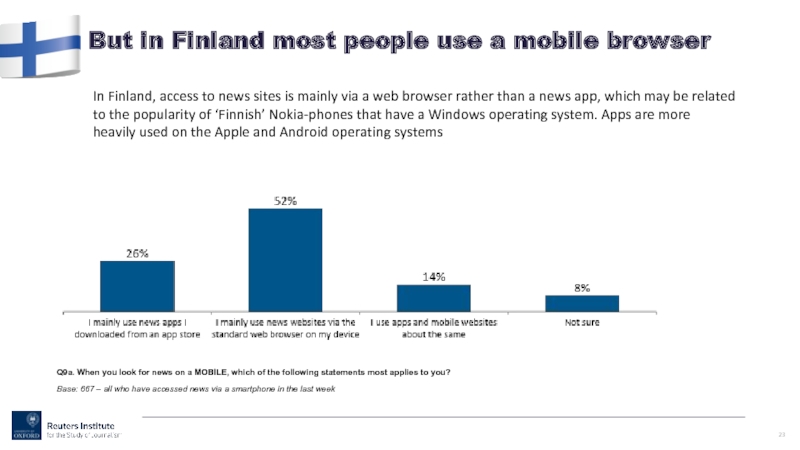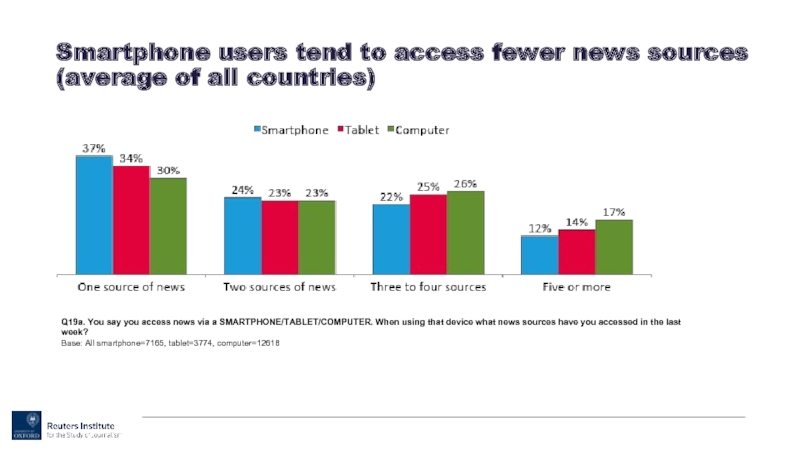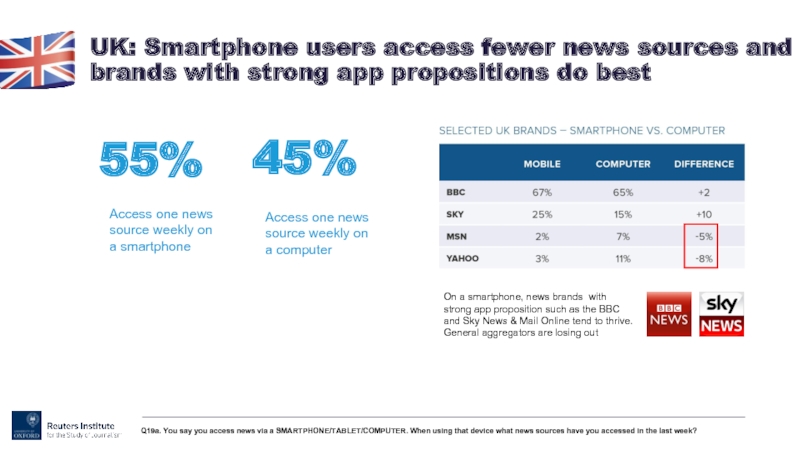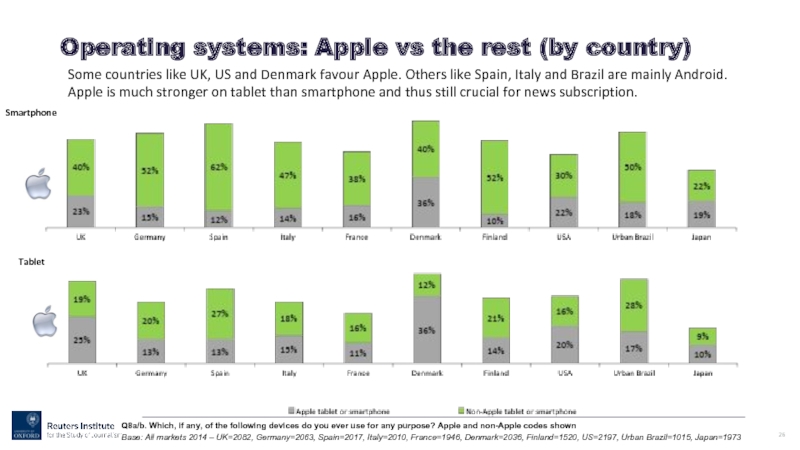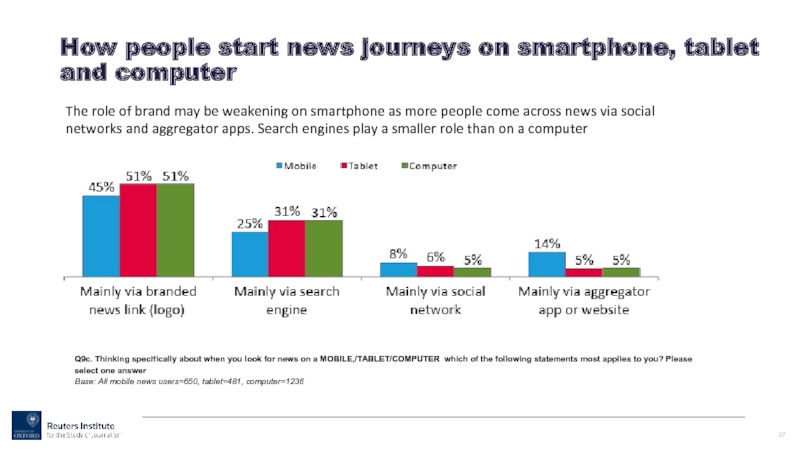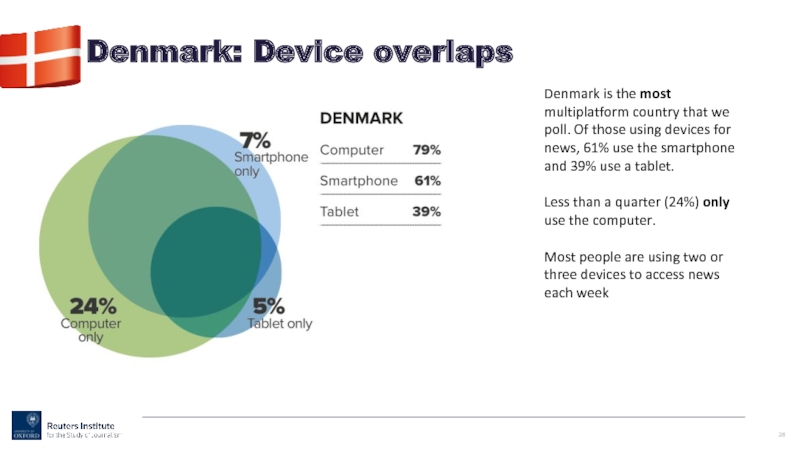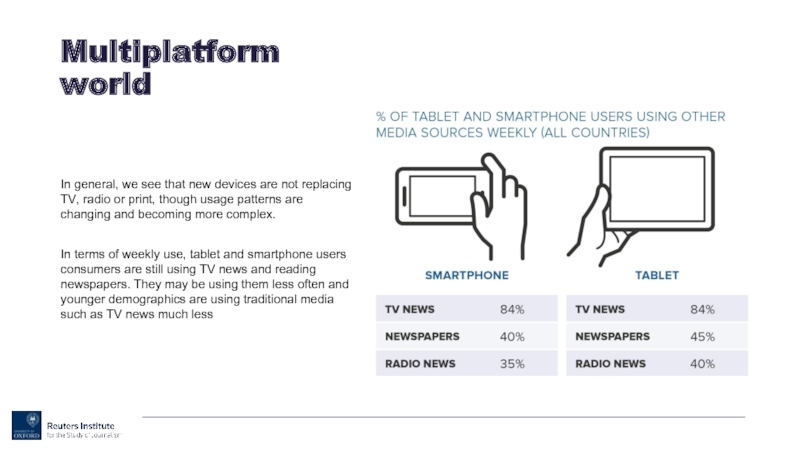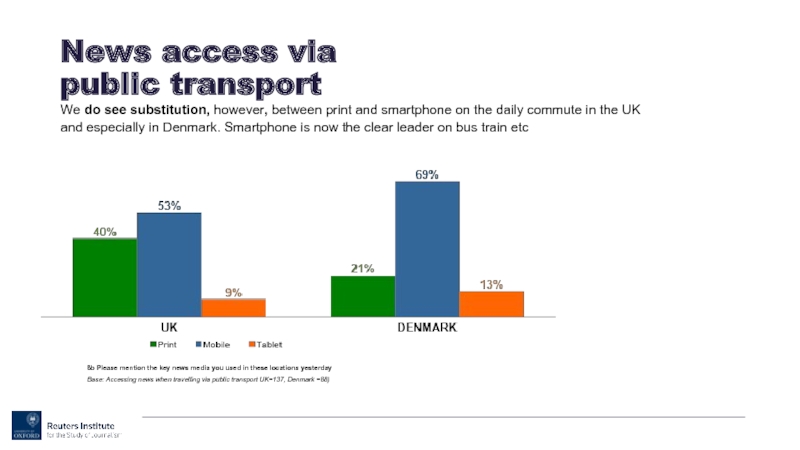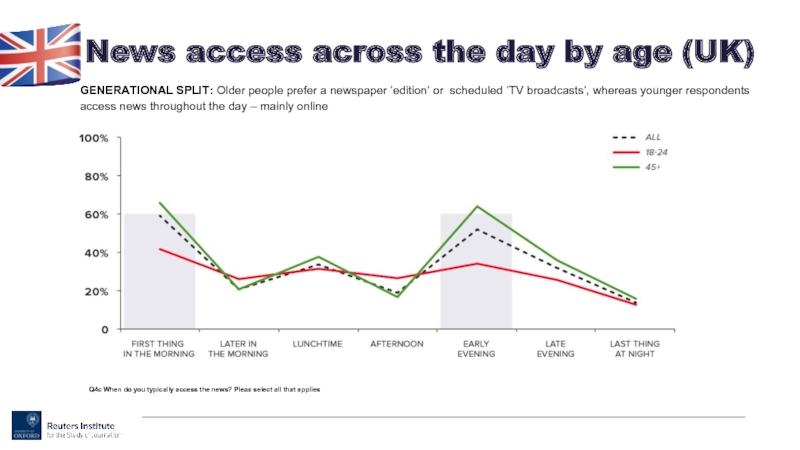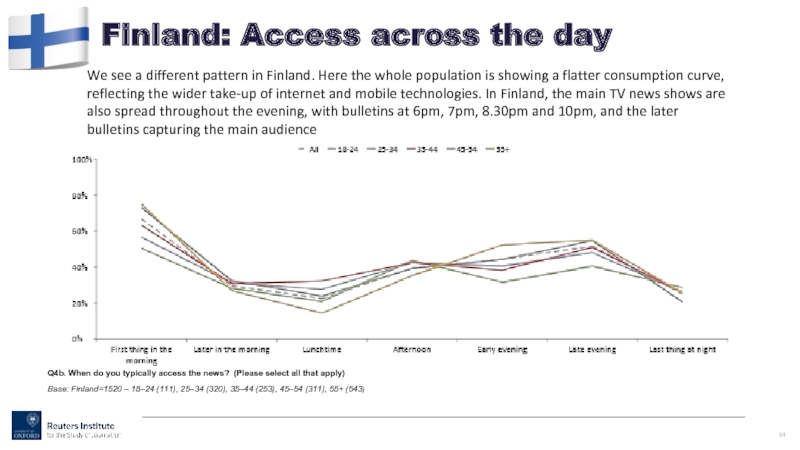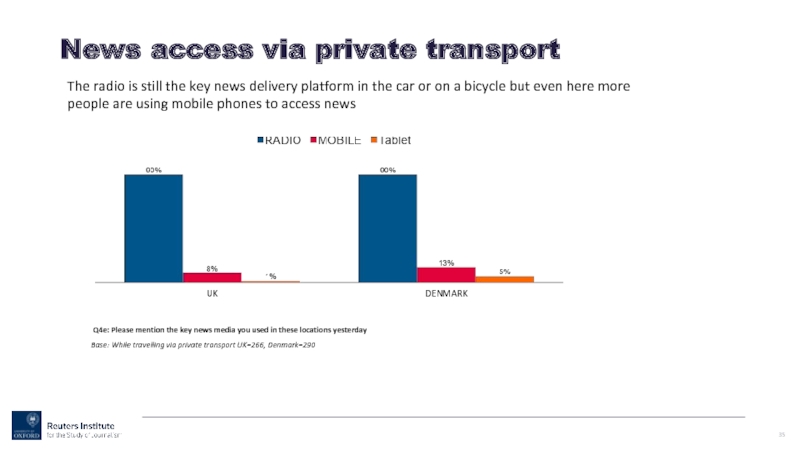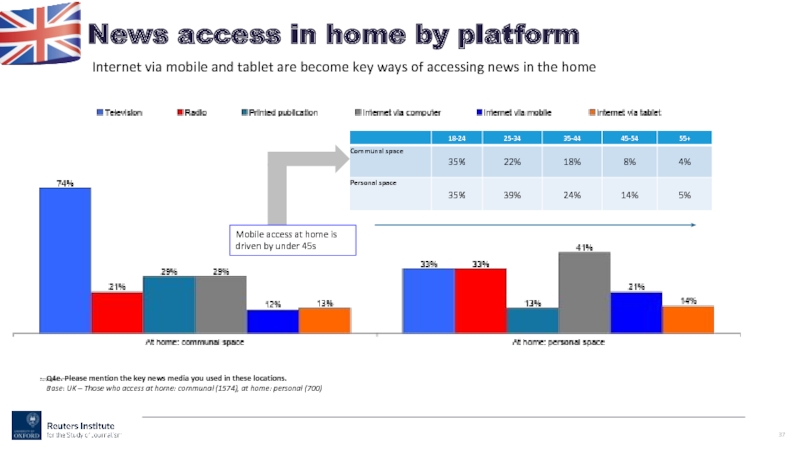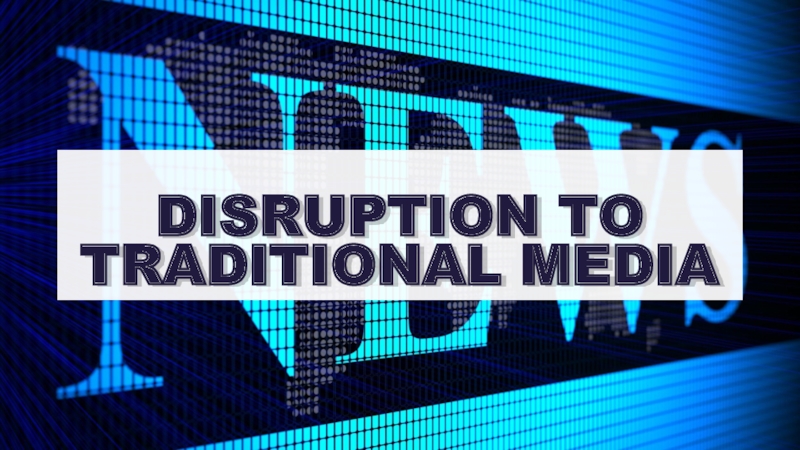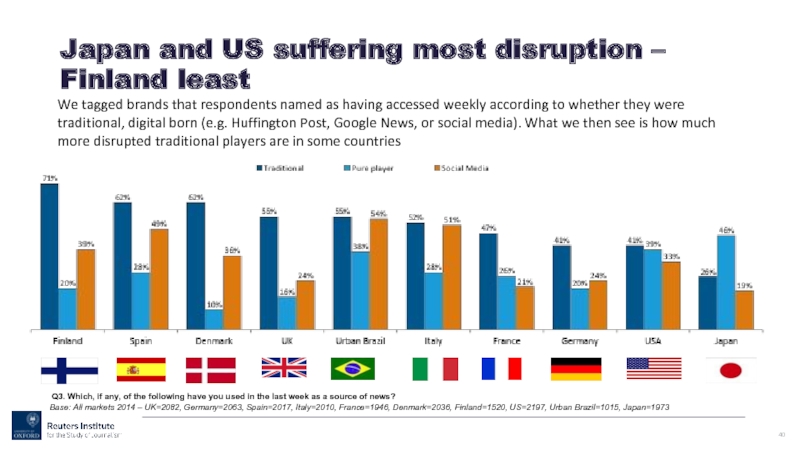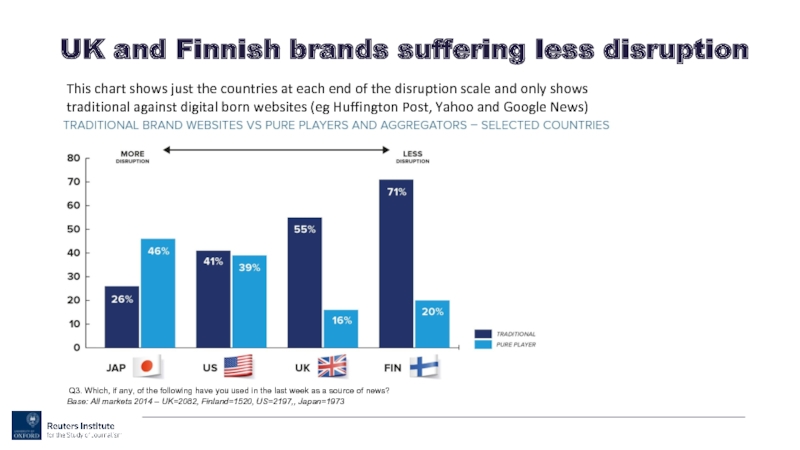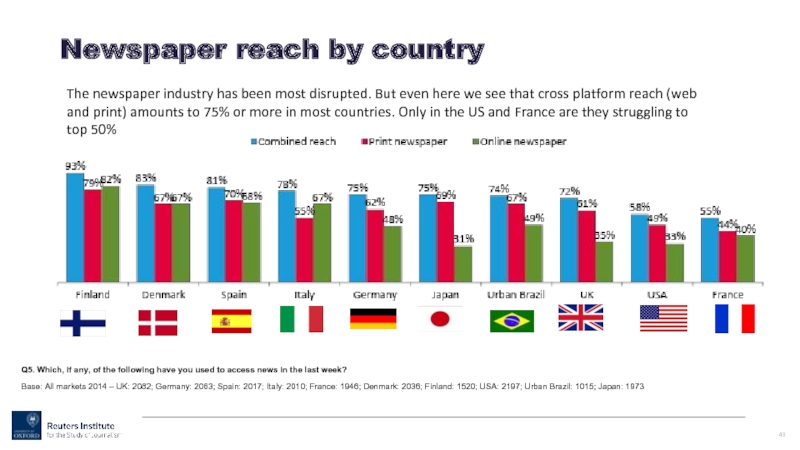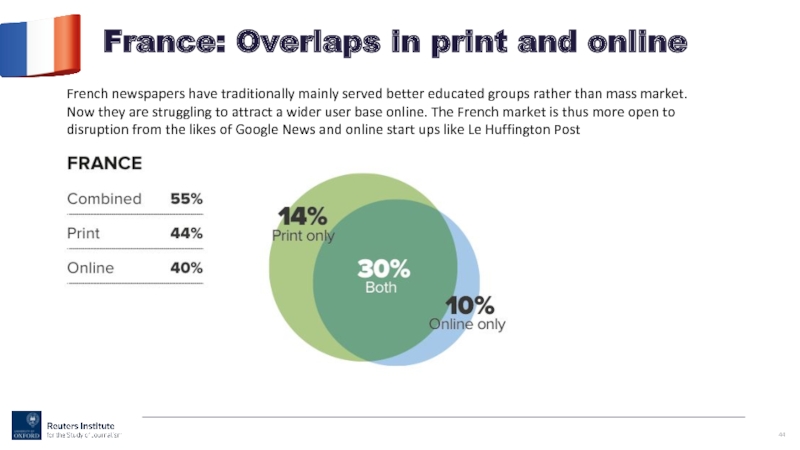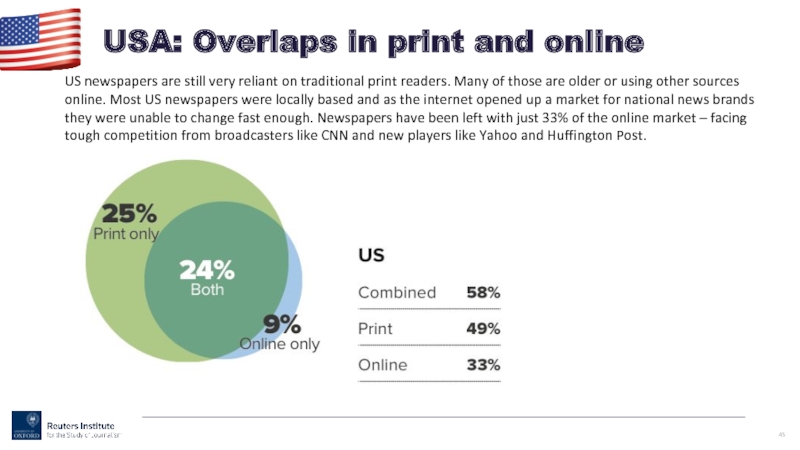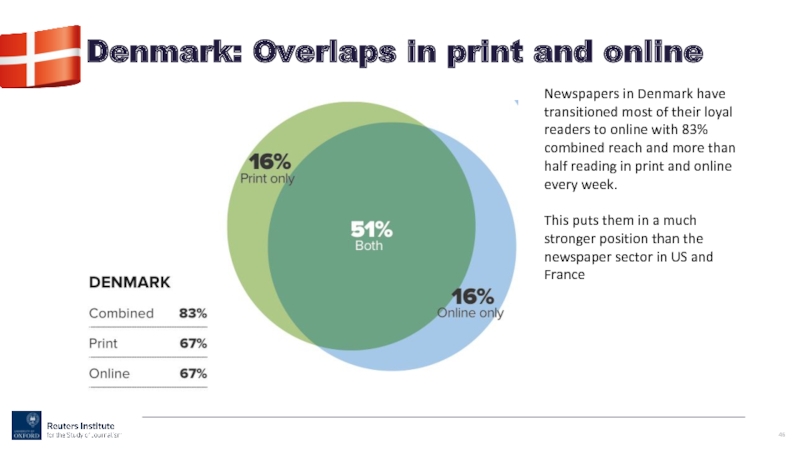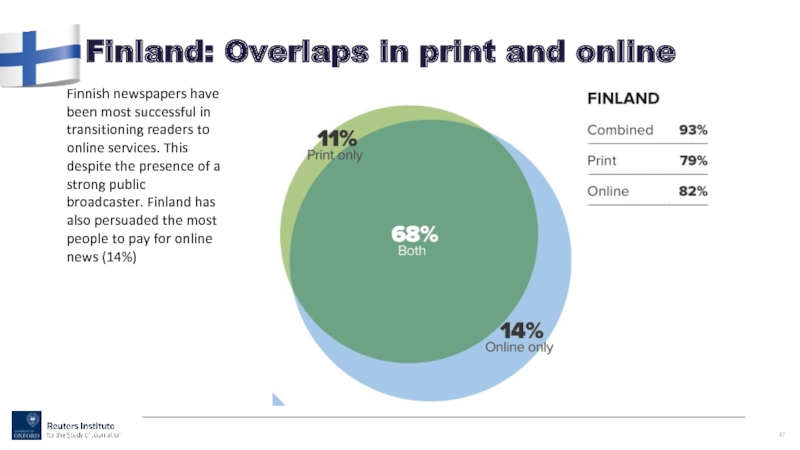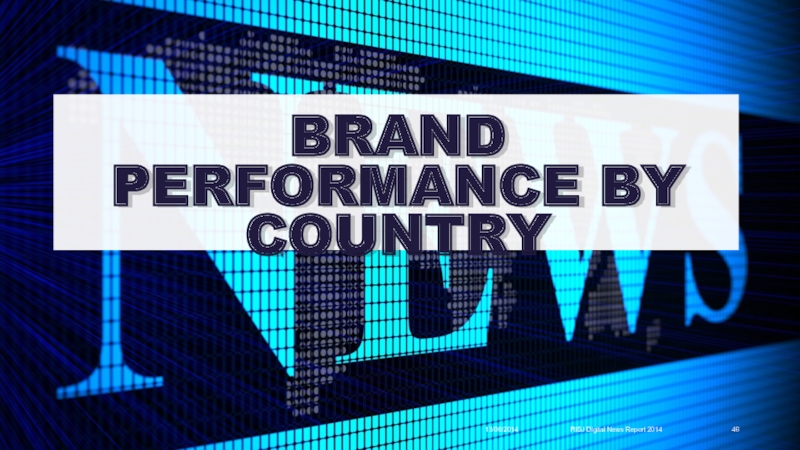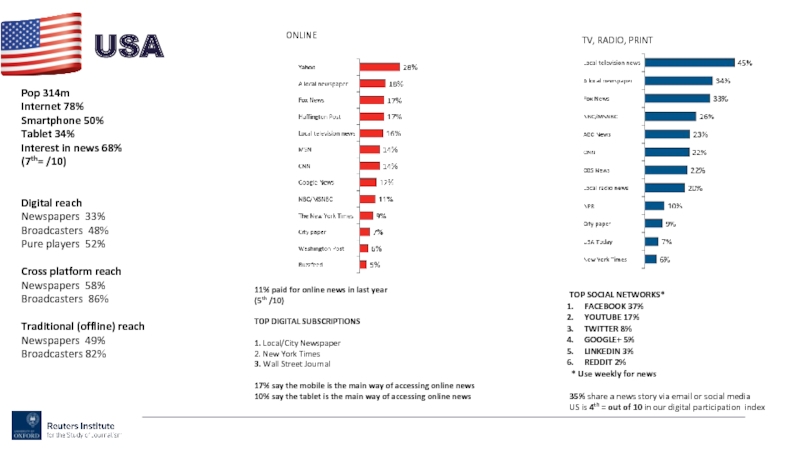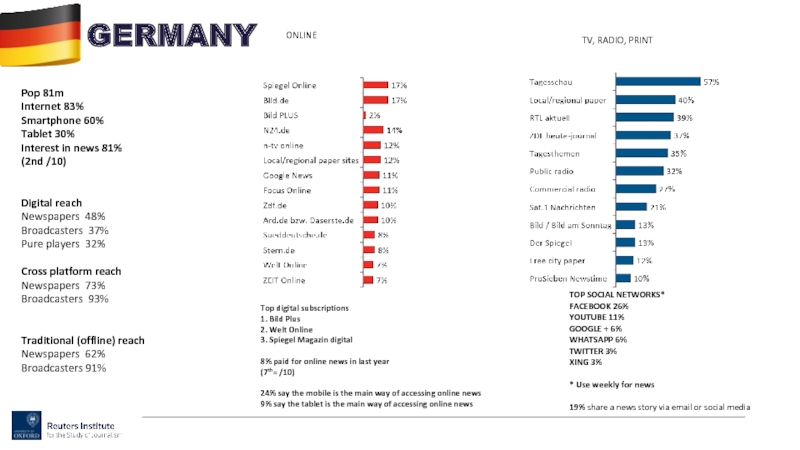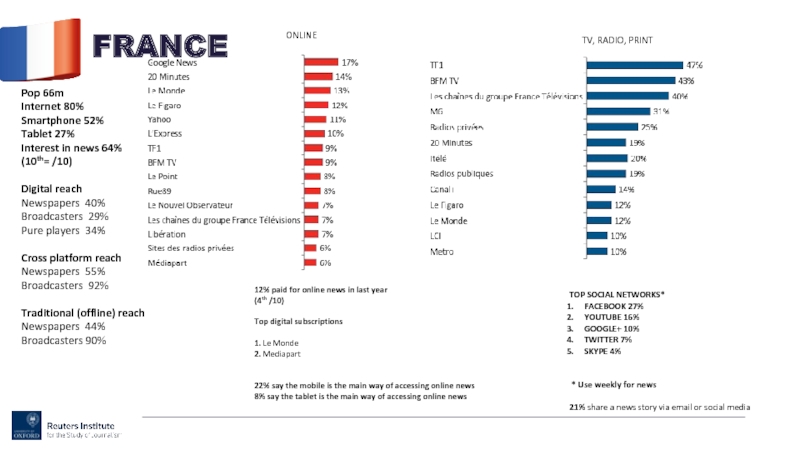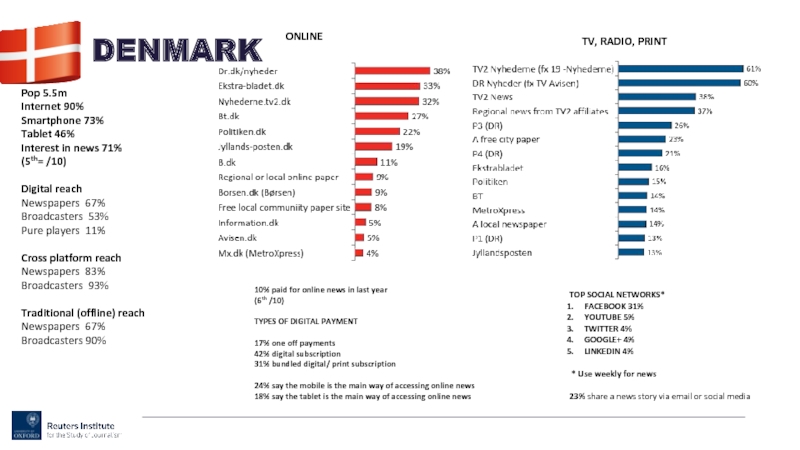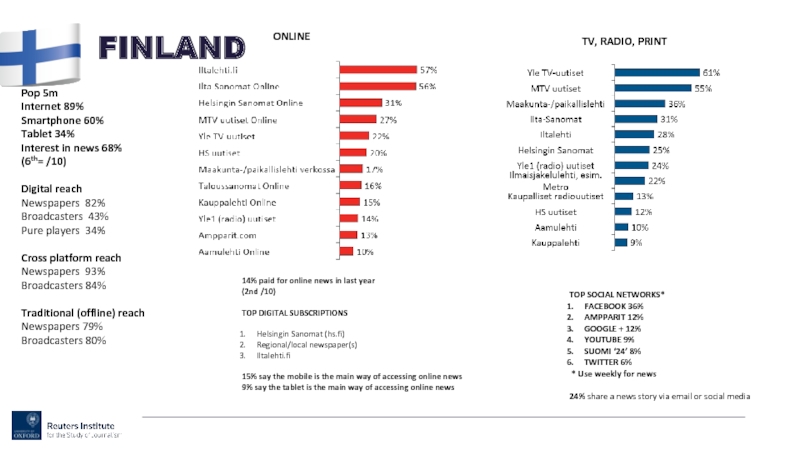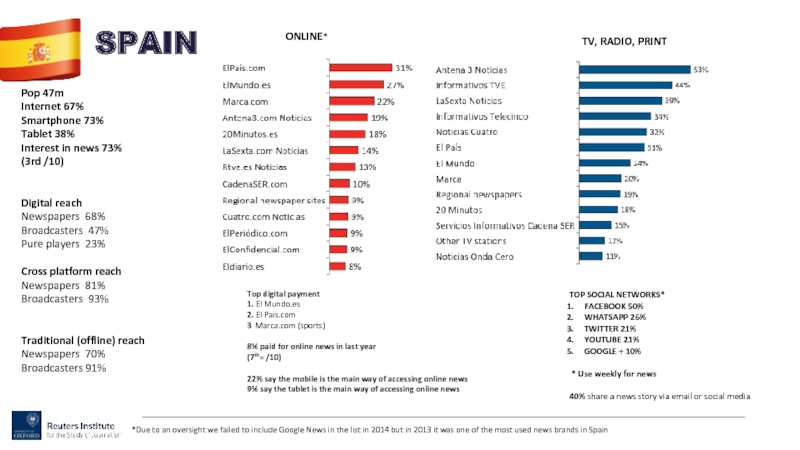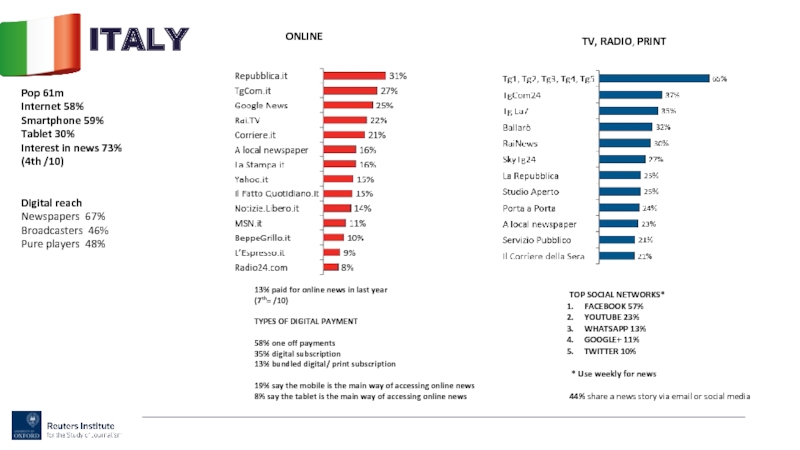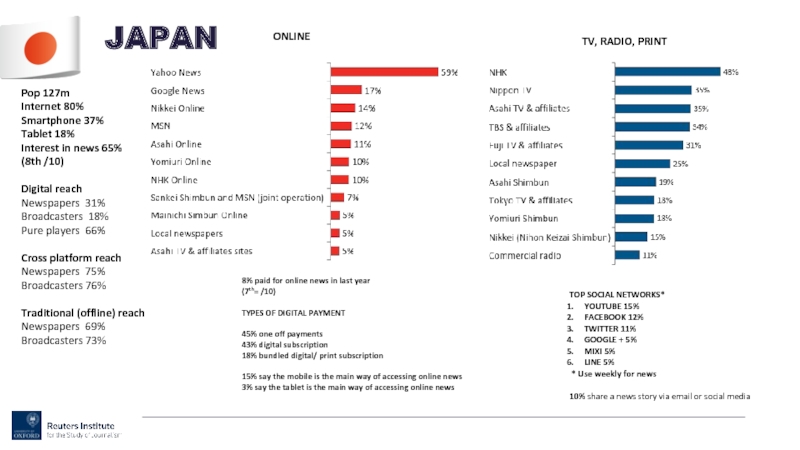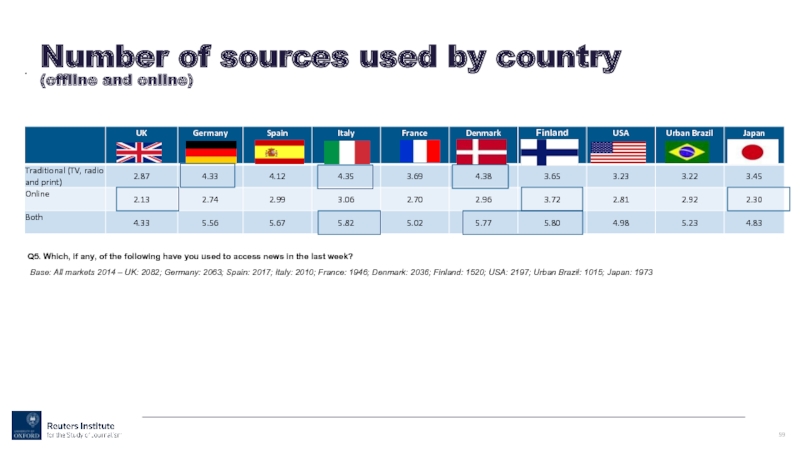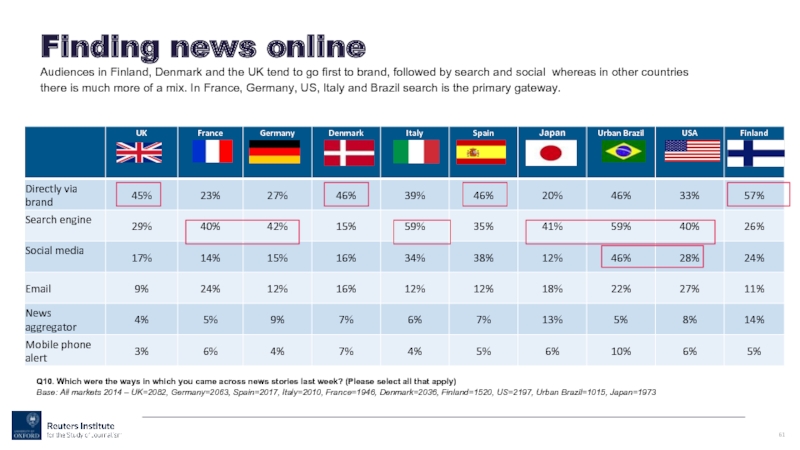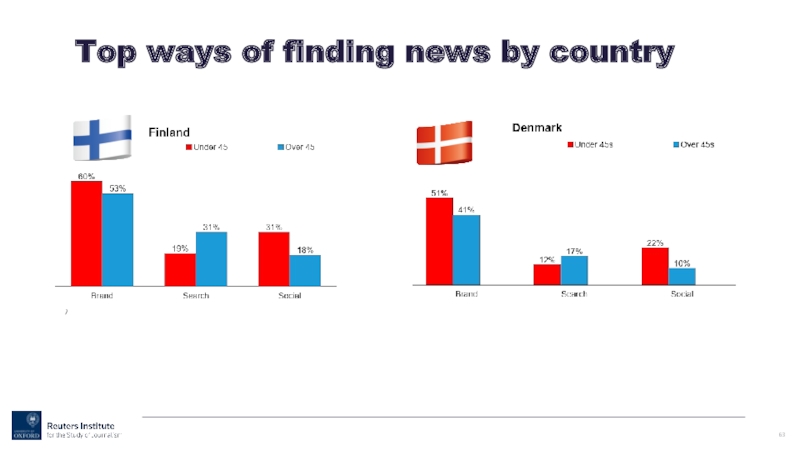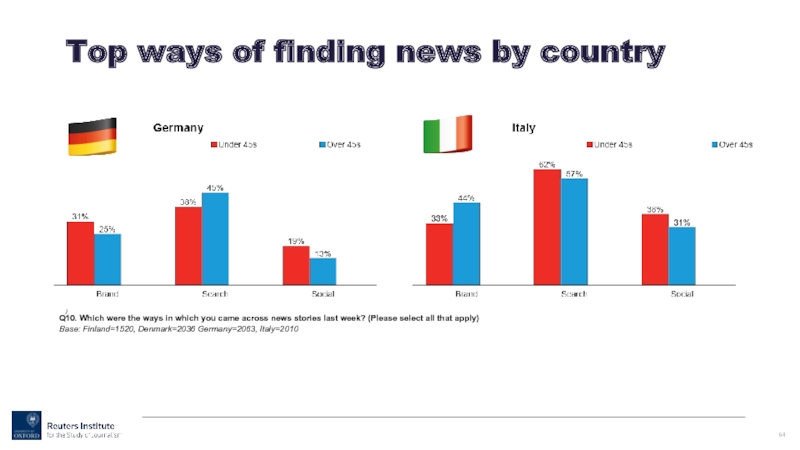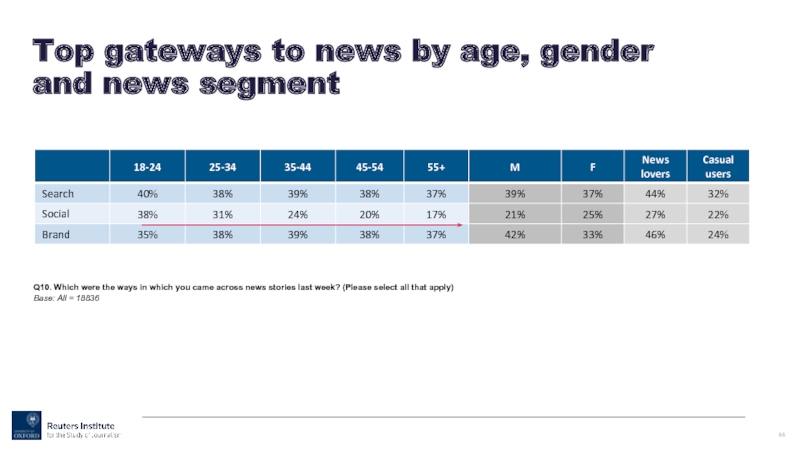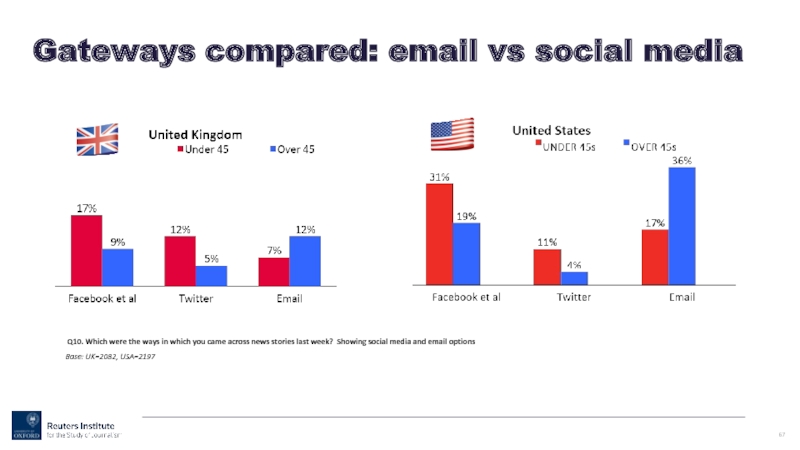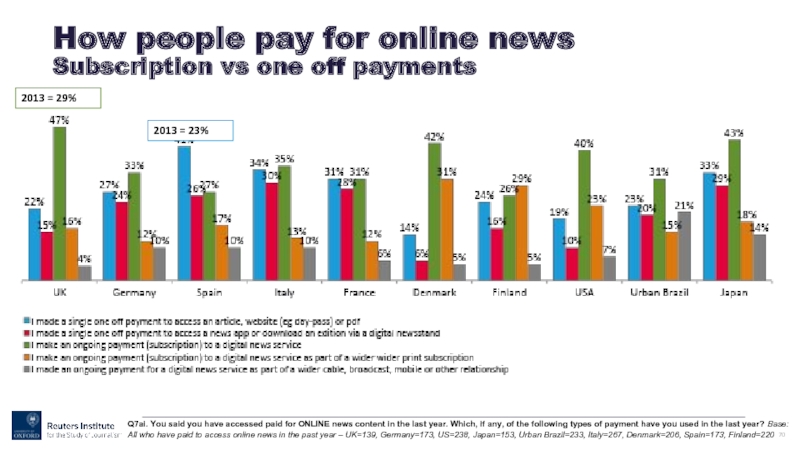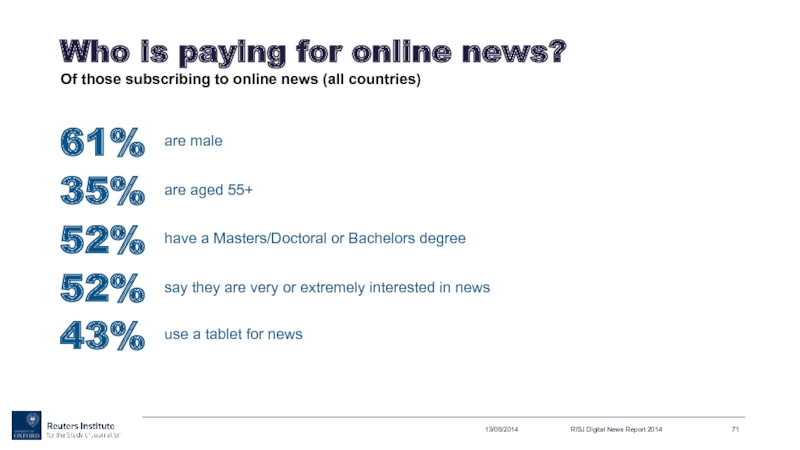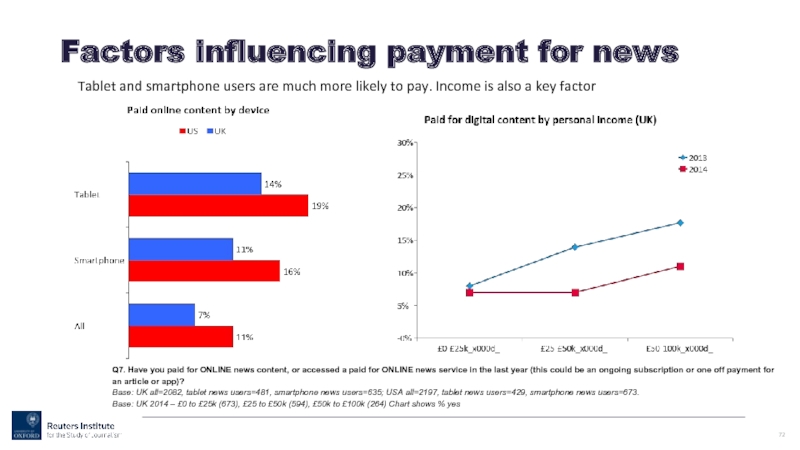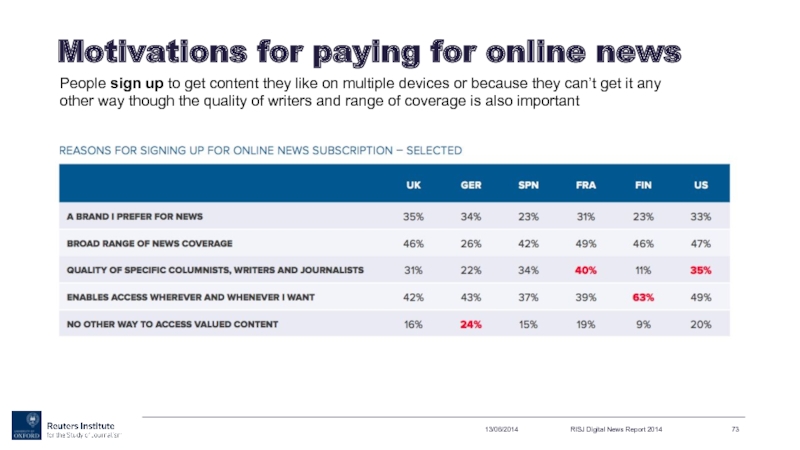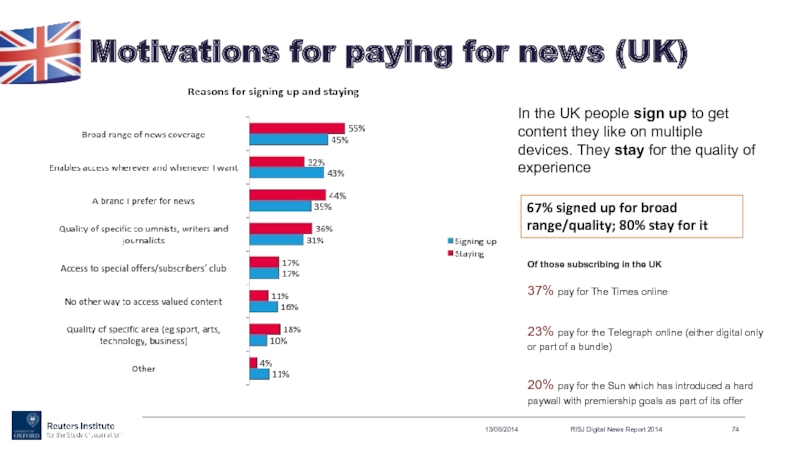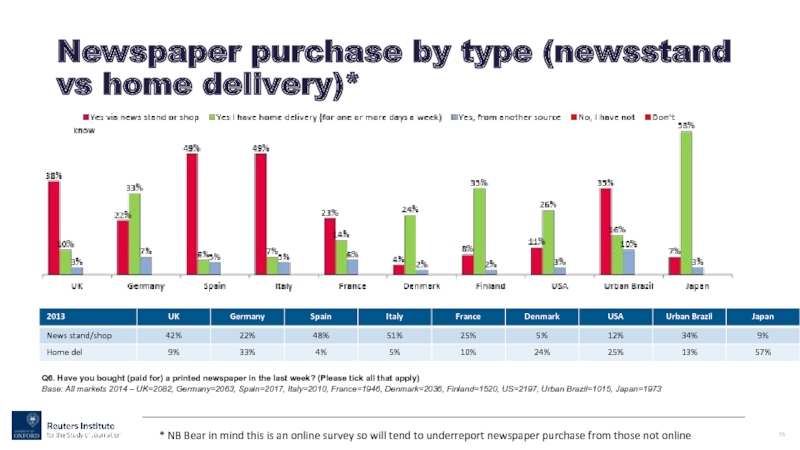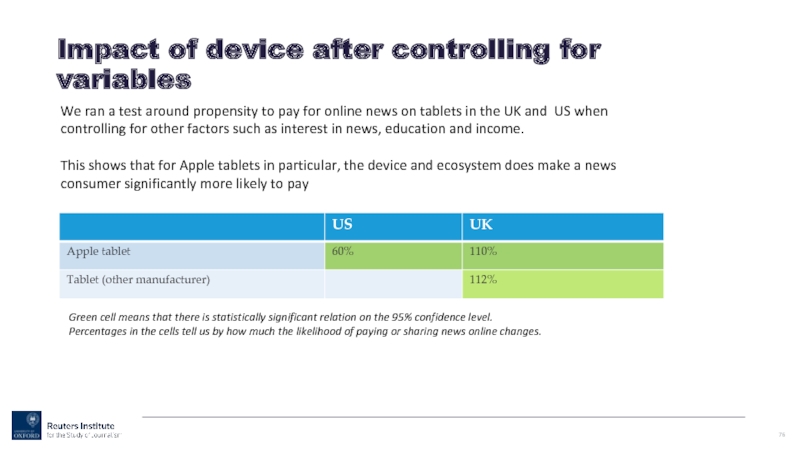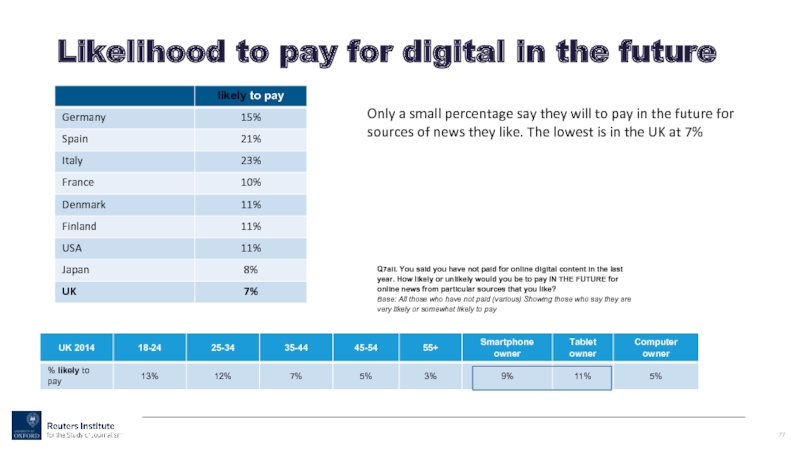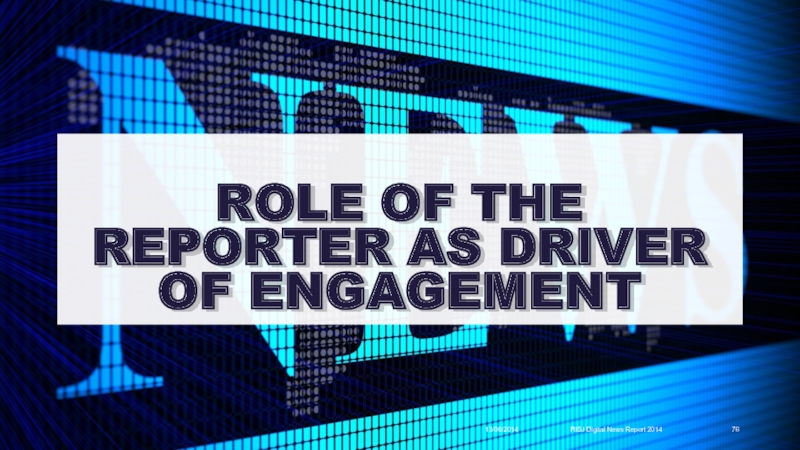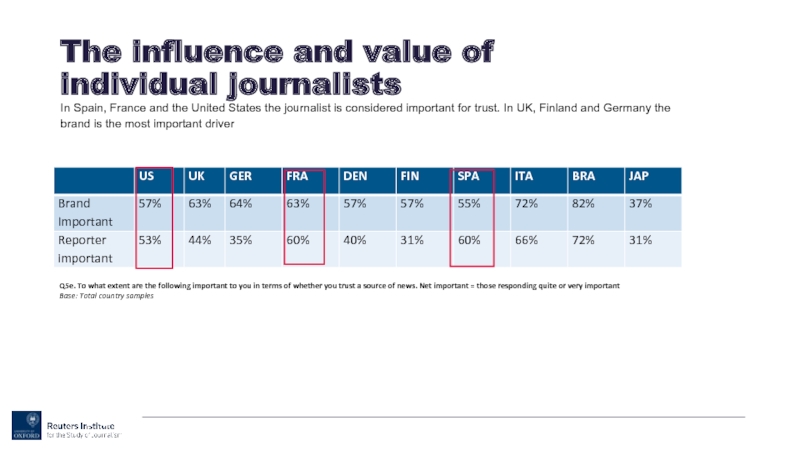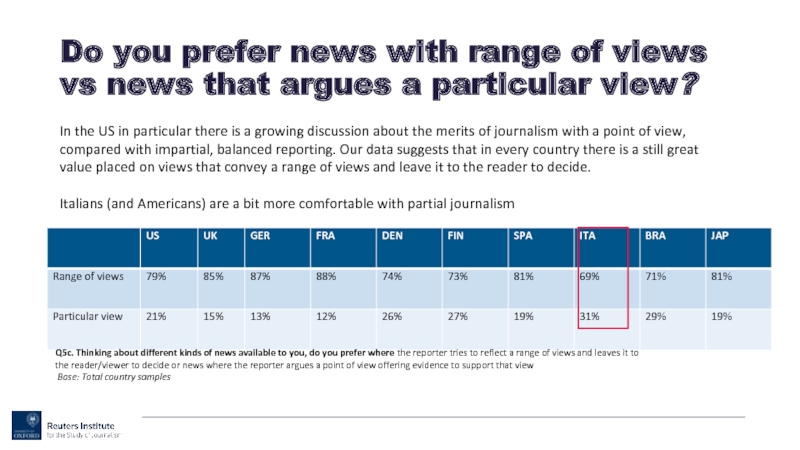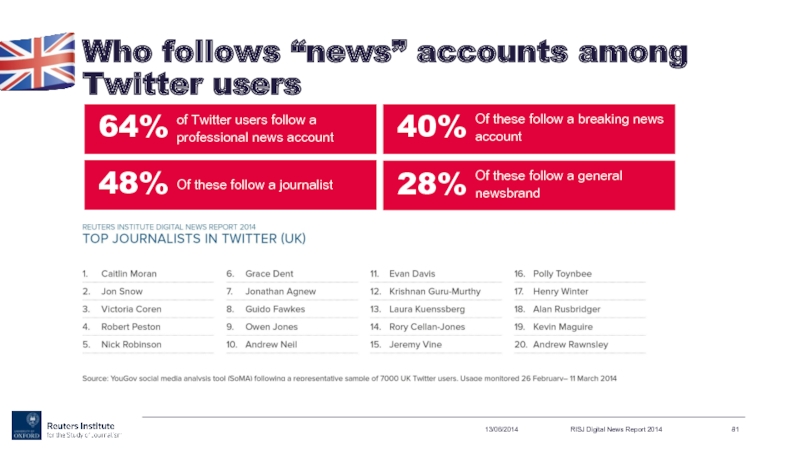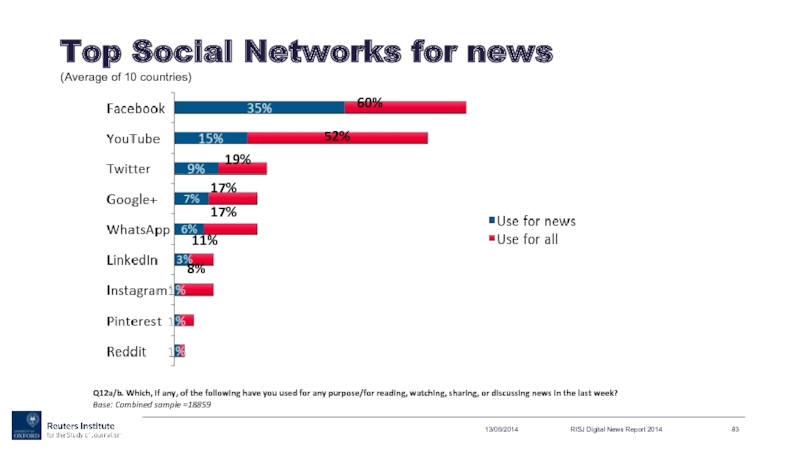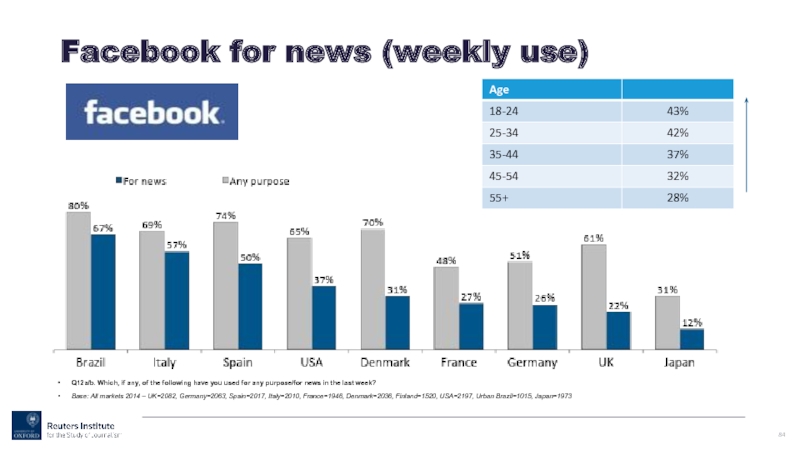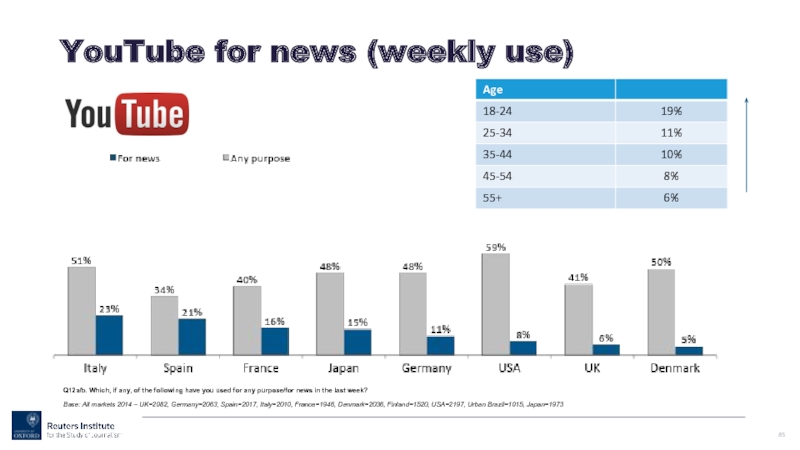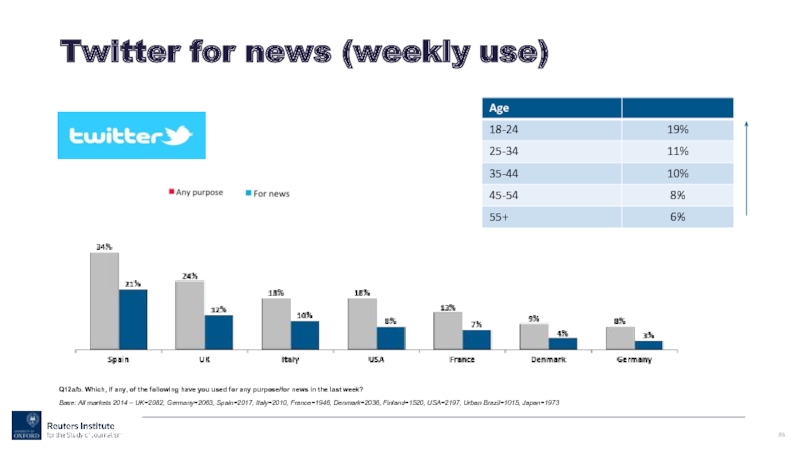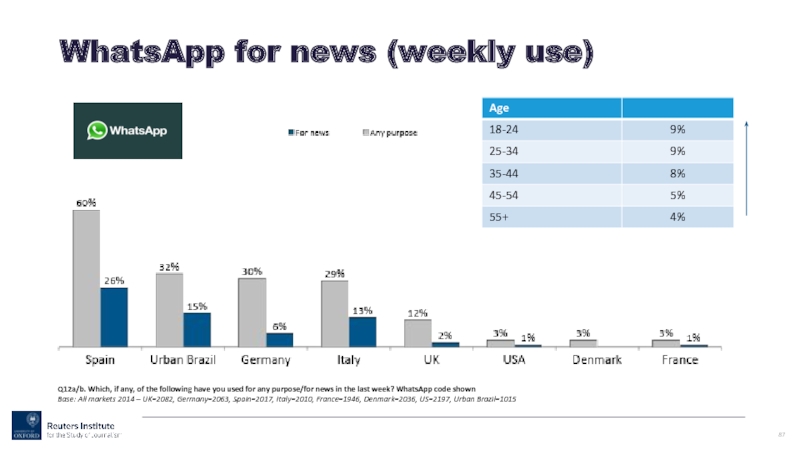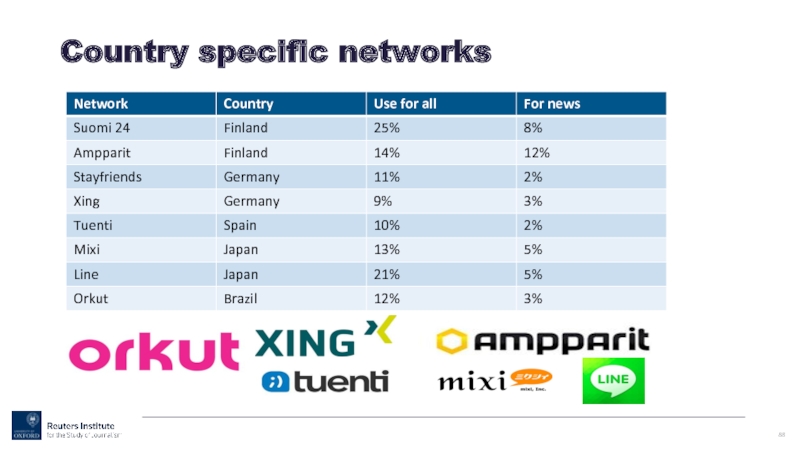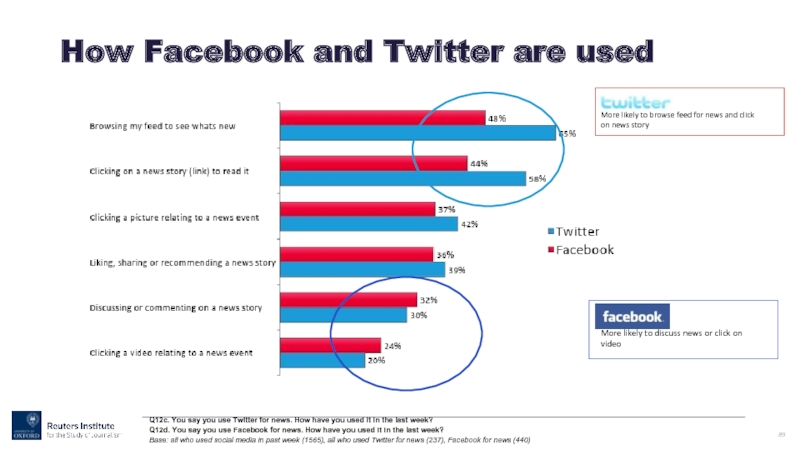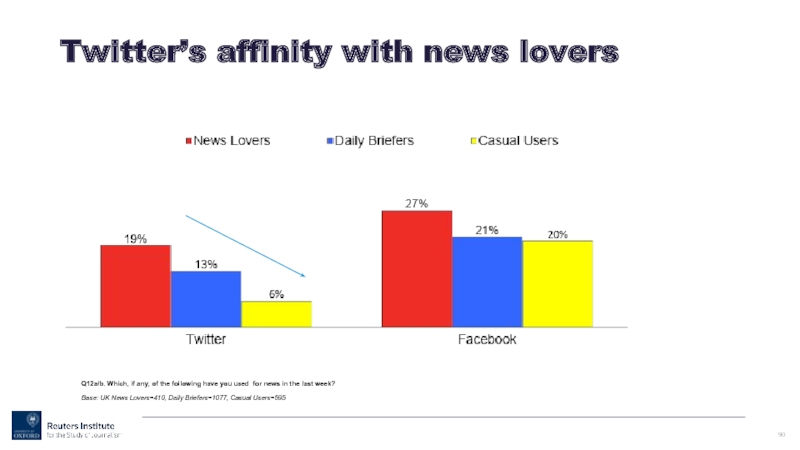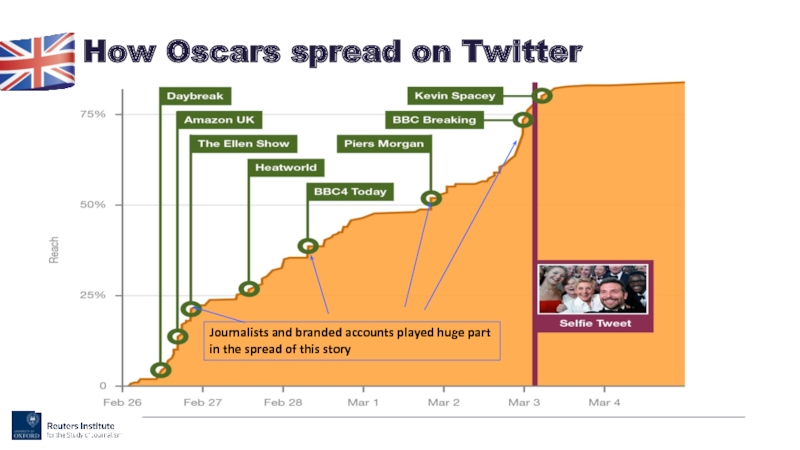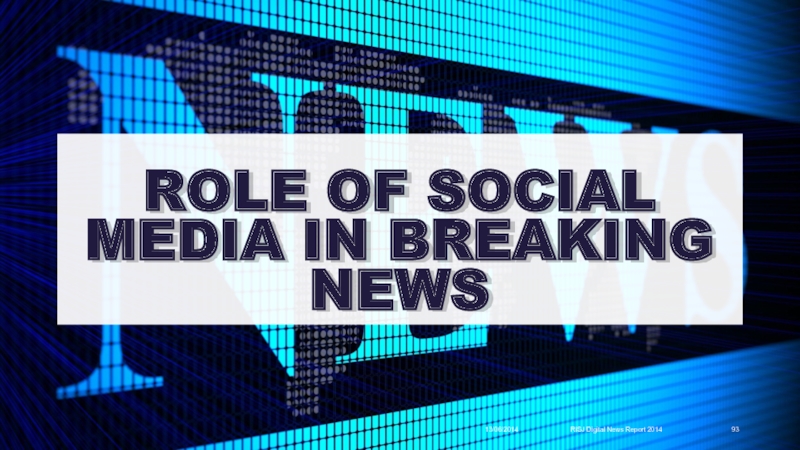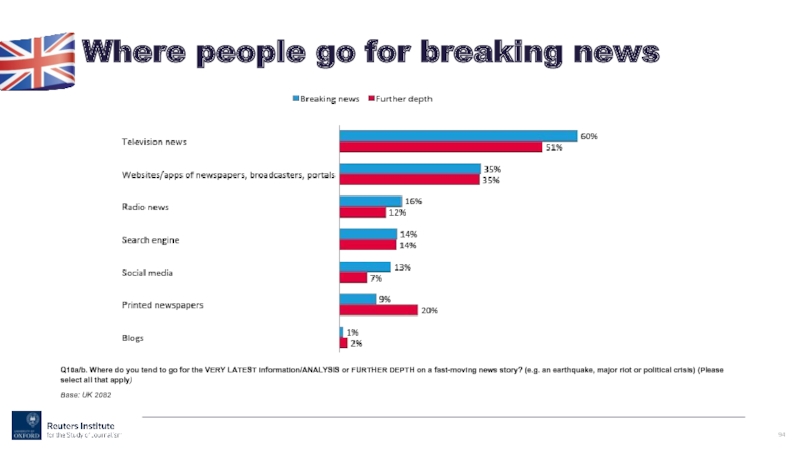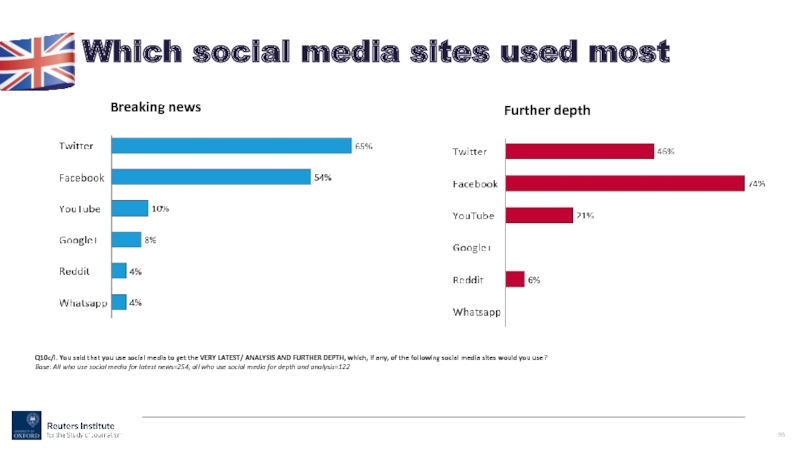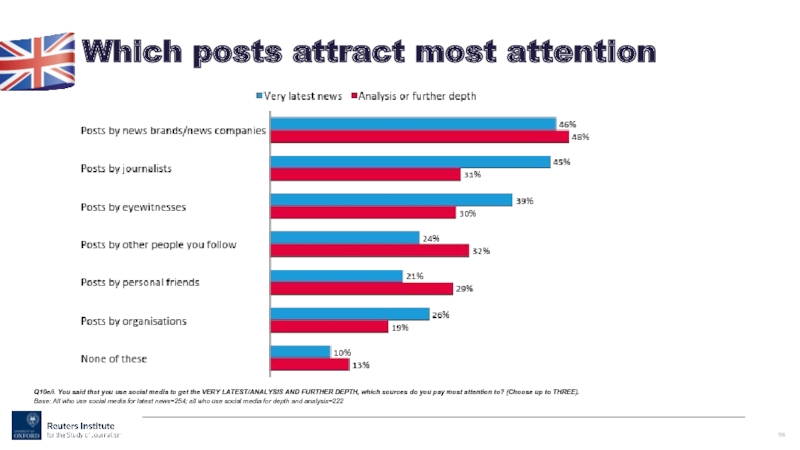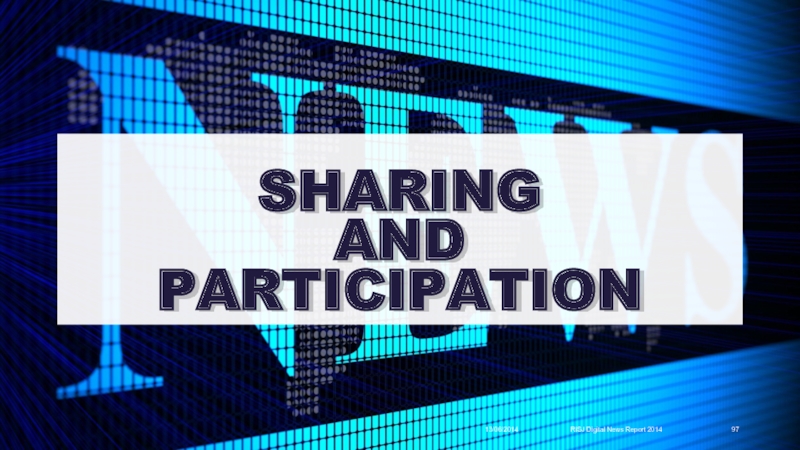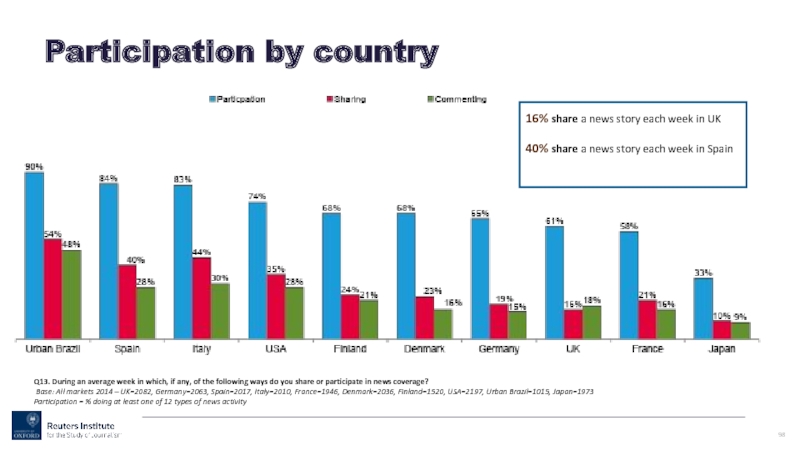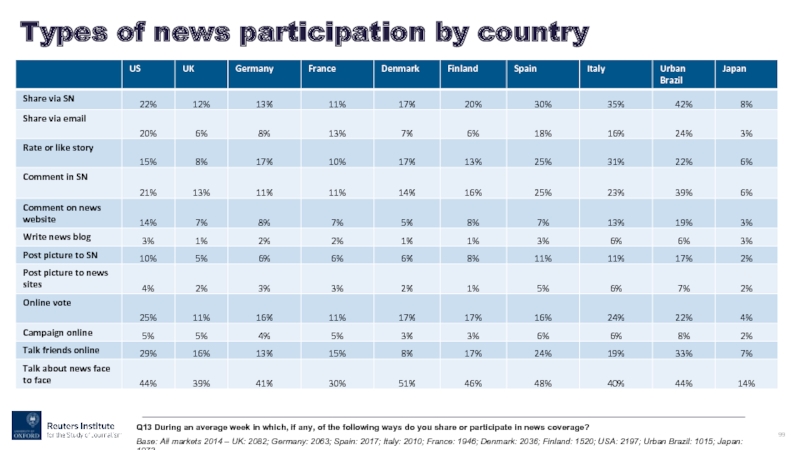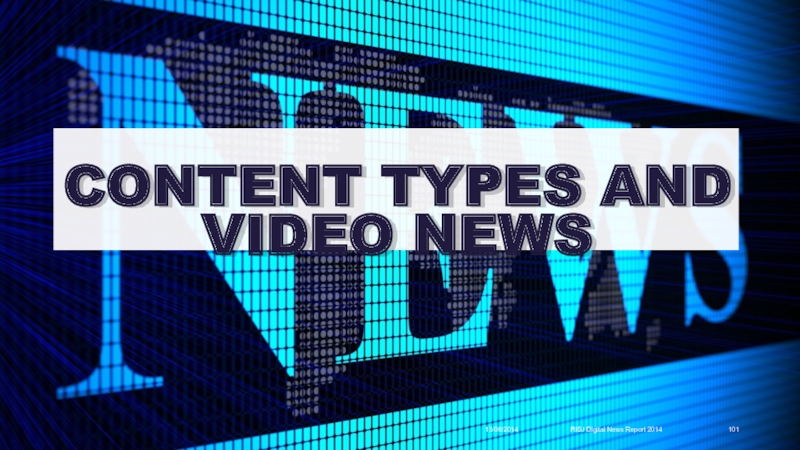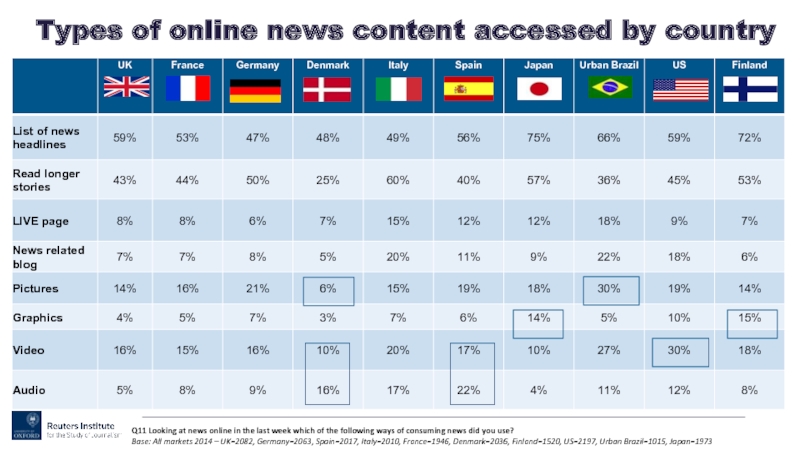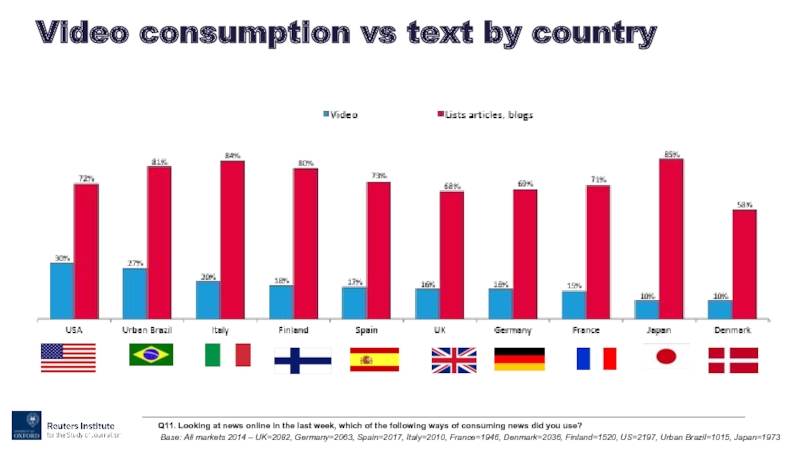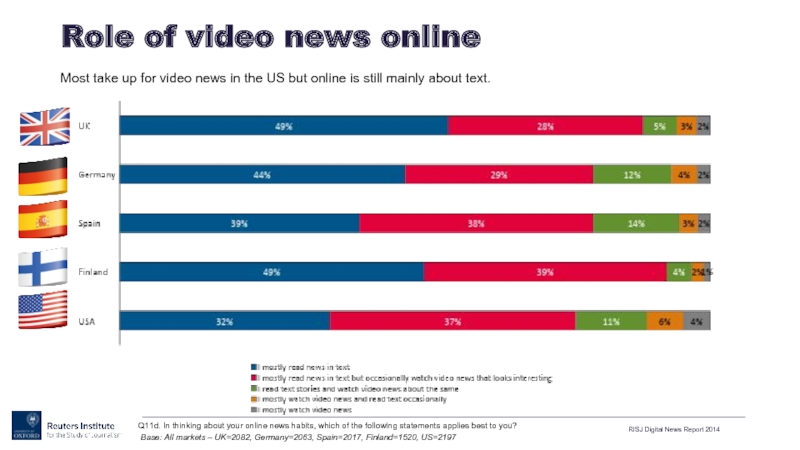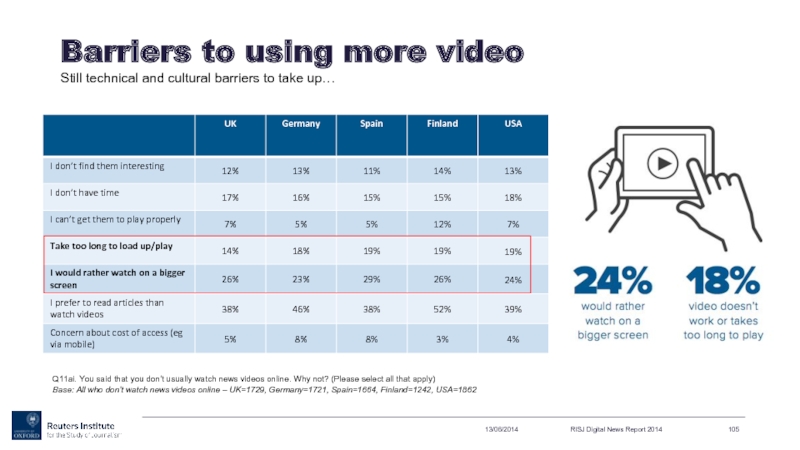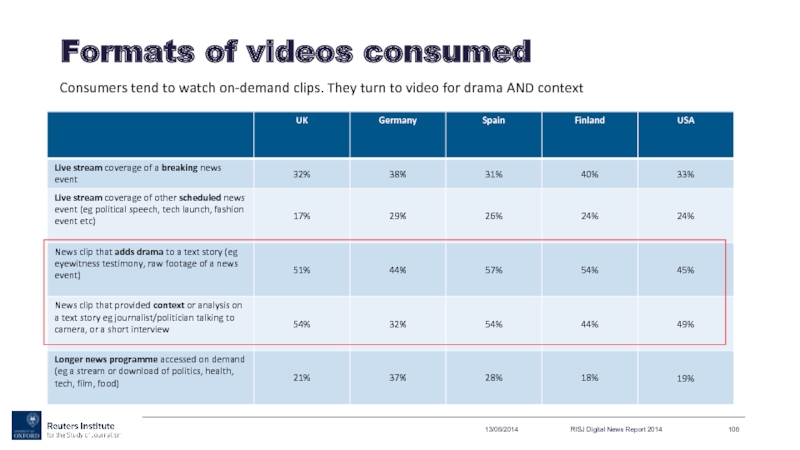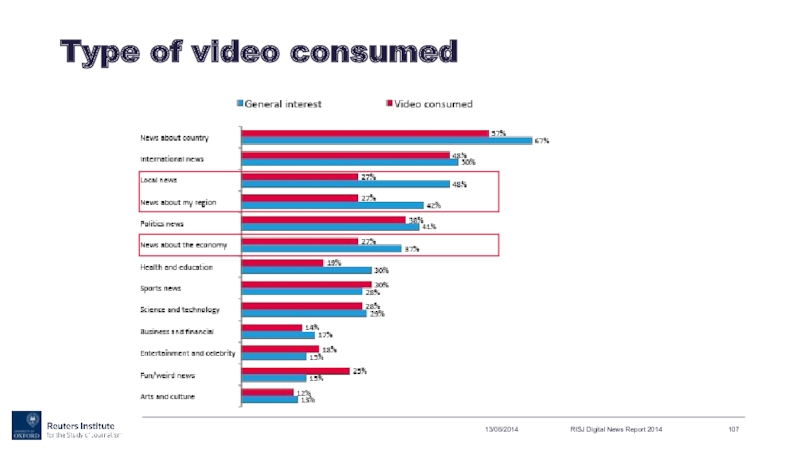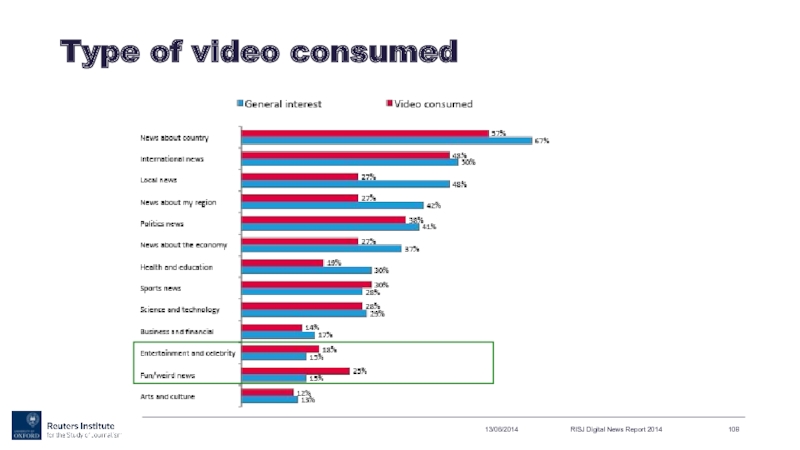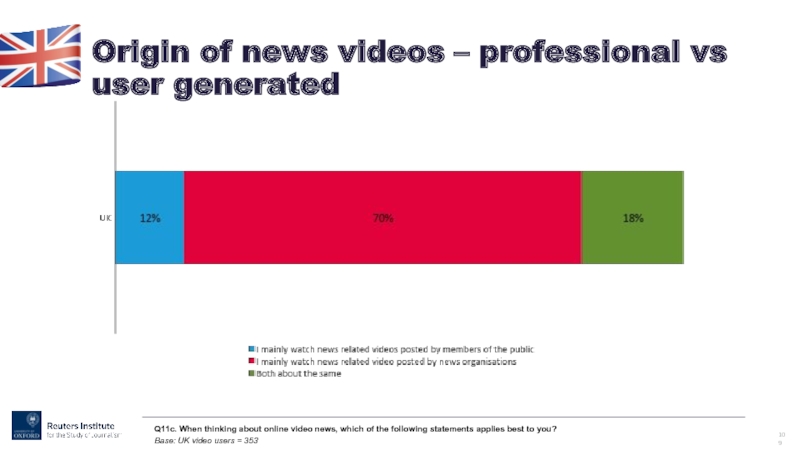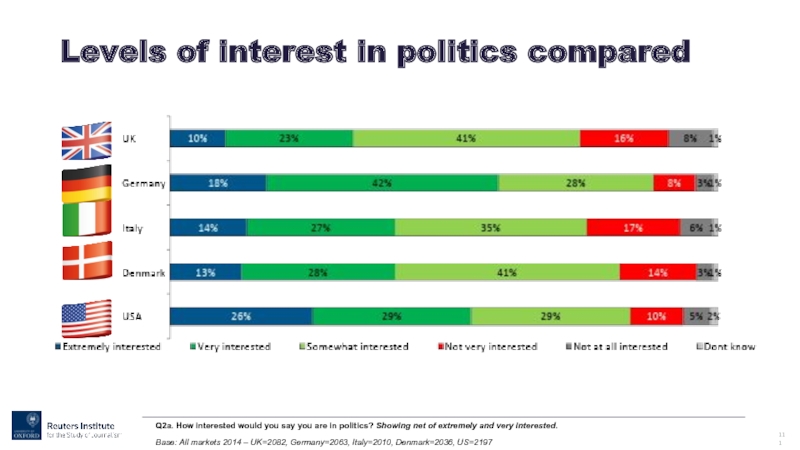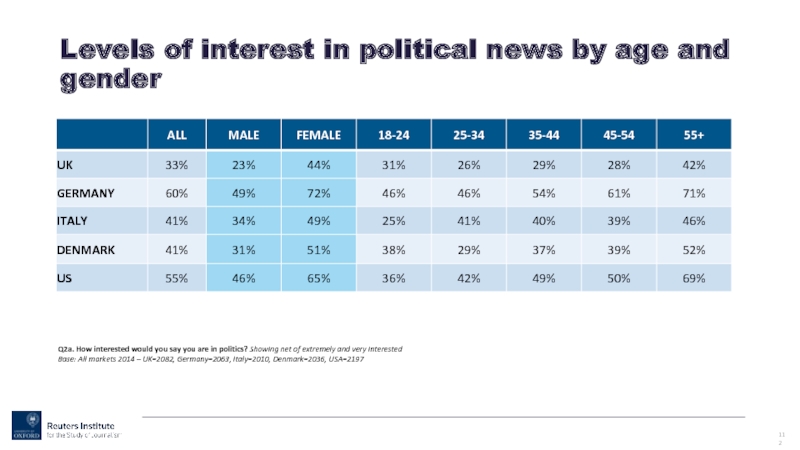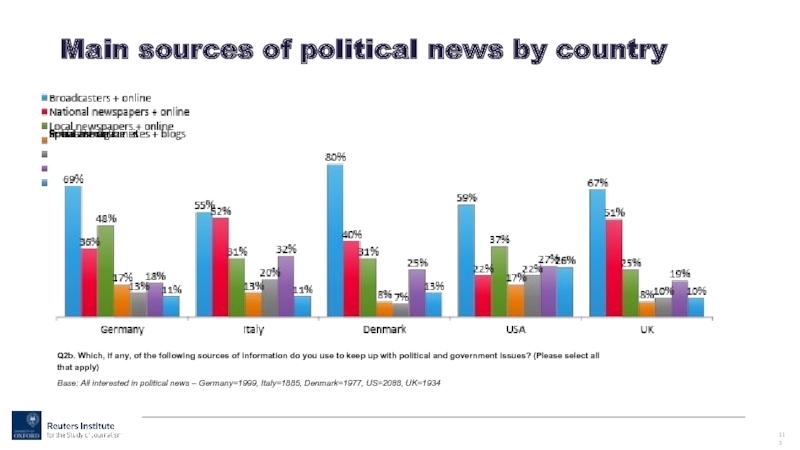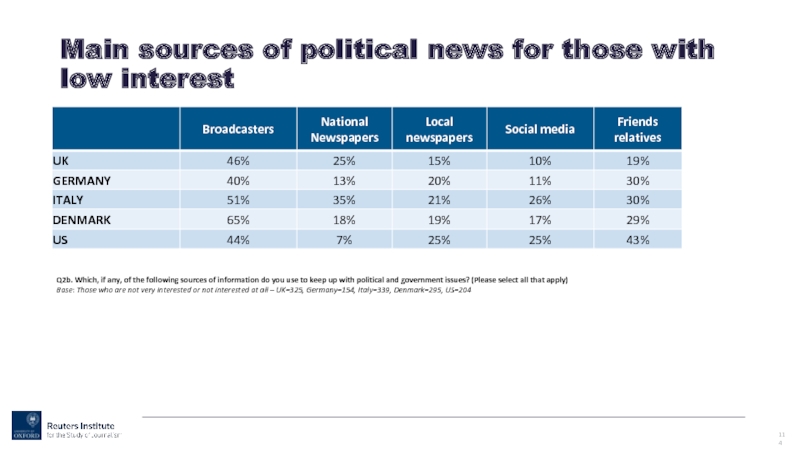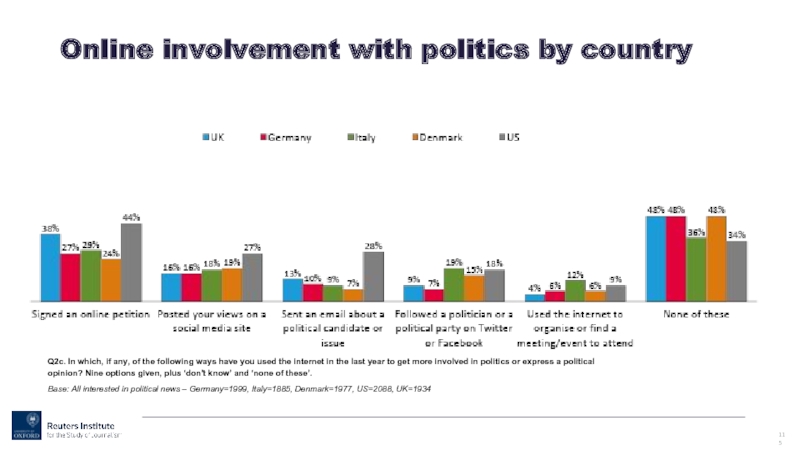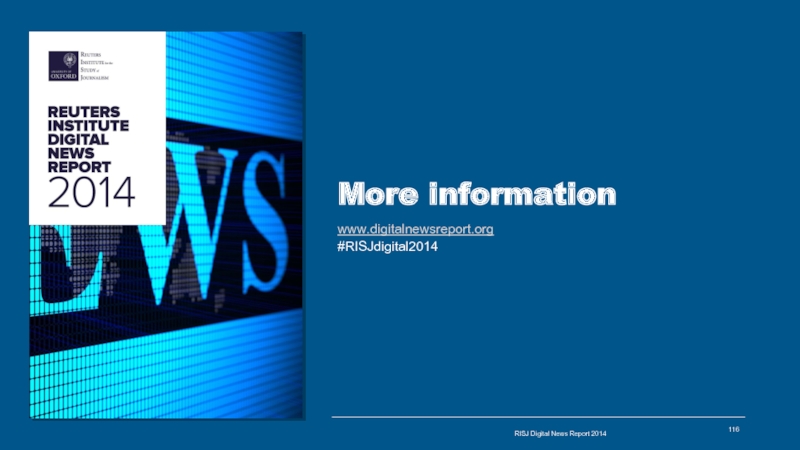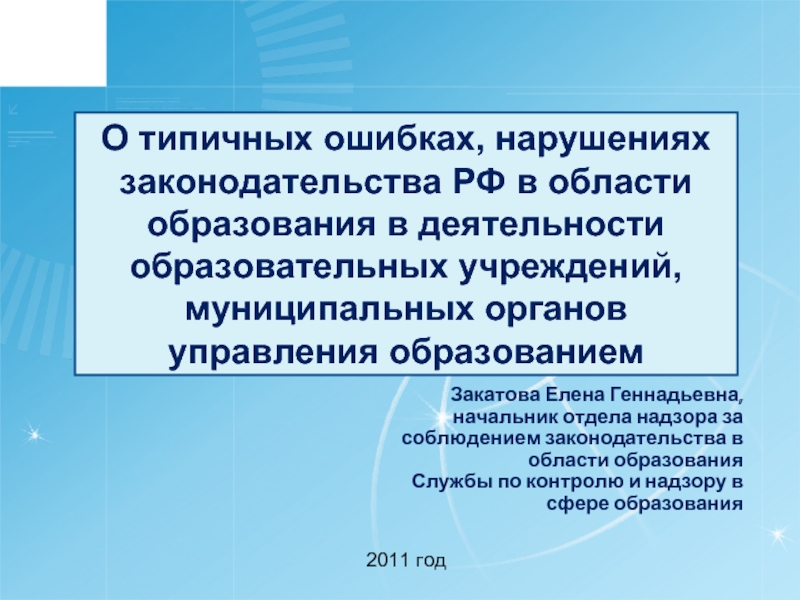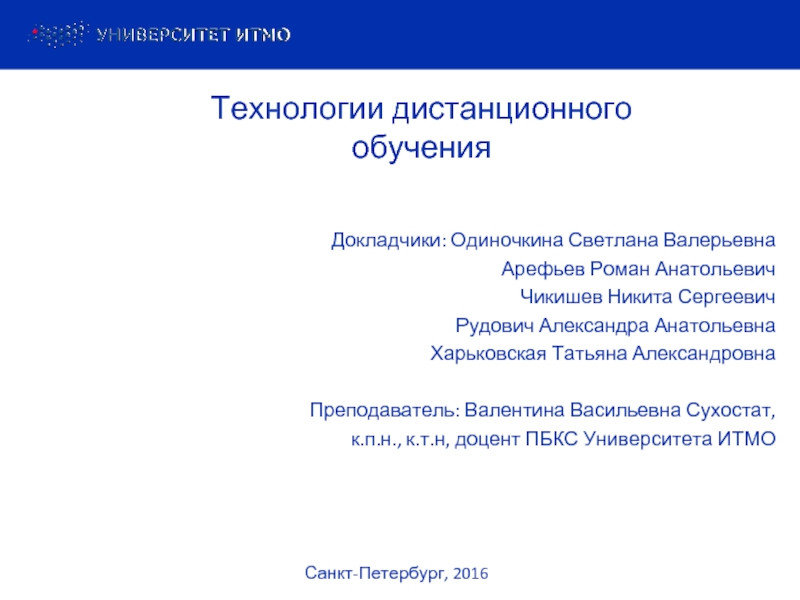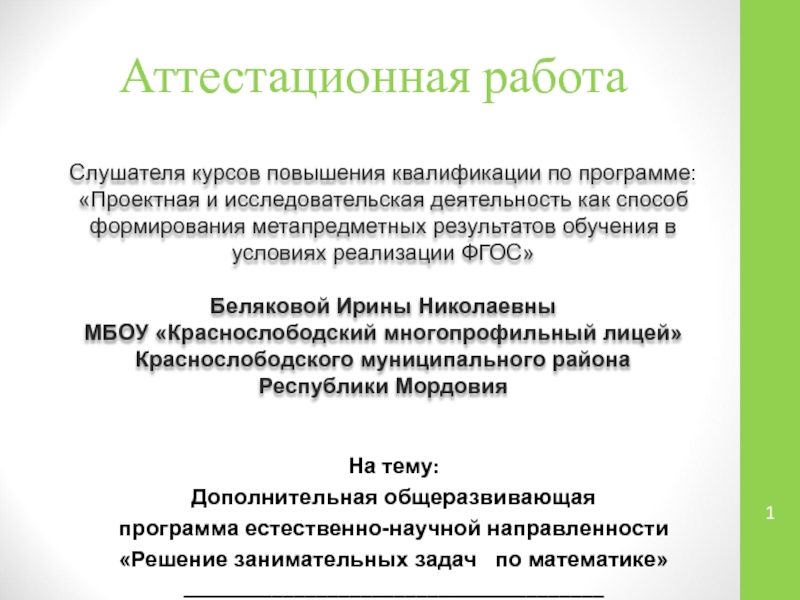- Главная
- Разное
- Дизайн
- Бизнес и предпринимательство
- Аналитика
- Образование
- Развлечения
- Красота и здоровье
- Финансы
- Государство
- Путешествия
- Спорт
- Недвижимость
- Армия
- Графика
- Культурология
- Еда и кулинария
- Лингвистика
- Английский язык
- Астрономия
- Алгебра
- Биология
- География
- Детские презентации
- Информатика
- История
- Литература
- Маркетинг
- Математика
- Медицина
- Менеджмент
- Музыка
- МХК
- Немецкий язык
- ОБЖ
- Обществознание
- Окружающий мир
- Педагогика
- Русский язык
- Технология
- Физика
- Философия
- Химия
- Шаблоны, картинки для презентаций
- Экология
- Экономика
- Юриспруденция
TRACKING THE FUTURE OF NEWS презентация
Содержание
- 1. TRACKING THE FUTURE OF NEWS
- 2. Licensing and terms of use You are
- 3. Key findings Role of smartphone as
- 4. Background and methodology One of the
- 5. INTEREST IN NEWS AND TYPES OF USERS 13/06/2014 RISJ Digital News Report 2014
- 6. Q1c. How interested, if at all, would
- 7. Q1c. How interested, if at all, would
- 8. Q4. You say you’ve used these sources
- 9. Q4. You say you’ve used these sources
- 10. Q4. You say you’ve used these sources
- 11. Q2 Which of the following types of
- 12. Q2. Which of the following types of
- 13. Q2. Which of the following types of
- 14. Types of news users drawn from interest
- 15. SMARTPHONES AND TABLETS
- 16. Strong growth in SMARTPHONE news access
- 17. Strong growth in TABLET access Denmark
- 18. Impact and value of new devices
- 19. Q1b. Typically, how often do you access
- 20. Smartphone and tablet demographics Smartphones are still
- 21. 45-54 group use most news apps
- 22. Q9a. When you look for news on
- 23. Q9a. When you look for news on
- 24. Smartphone users tend to access fewer news
- 25. UK: Smartphone users access fewer news sources
- 26. Q8a/b. Which, if any, of the following
- 27. Q9c. Thinking specifically about when you look
- 28. Denmark: Device overlaps Denmark is the most
- 29. Japan: Device overlaps Japan is the least
- 30. Multiplatform world In general, we see
- 31. News access via public transport We
- 32. From brand’s point of view… It’s an
- 33. News access across the day by age
- 34. Q4b. When do you typically access the
- 35. Q4e: Please mention the key news
- 36. Where were you when you looked at/listened
- 37. OPT4e_1. 'At home: communal space (living-room, kitchen,
- 38. OPT4e_1. 'At home: communal space (living-room, kitchen,
- 39. DISRUPTION TO TRADITIONAL MEDIA
- 40. Q3. Which, if any, of the
- 41. UK and Finnish brands suffering less disruption
- 42. New challengers The Huffington Post and Buzzfeed
- 43. Q5. Which, if any, of the following
- 44. France: Overlaps in print and online French
- 45. USA: Overlaps in print and online US
- 46. Denmark: Overlaps in print and online Newspapers
- 47. Finland: Overlaps in print and online Finnish
- 48. BRAND PERFORMANCE BY COUNTRY 13/06/2014 RISJ Digital News Report 2014
- 49. USA Pop 314m Internet 78% Smartphone
- 50. UK Pop 63m Internet 84% Smartphone
- 51. GERMANY Pop 81m Internet 83% Smartphone
- 52. FRANCE Pop 66m Internet 80% Smartphone
- 53. DENMARK Pop 5.5m Internet 90% Smartphone
- 54. FINLAND Pop 5m Internet 89% Smartphone
- 55. SPAIN Pop 47m Internet 67% Smartphone
- 56. ITALY Pop 61m Internet 58% Smartphone
- 57. BRAZIL Pop 193m* Internet 46% Smartphone
- 58. JAPAN Pop 127m Internet 80% Smartphone
- 59. Q5. Which, if any, of the following
- 60. FINDING NEWS ONLINE
- 61. Q10. Which were the ways in which
- 62. Social discovery 13/06/2014 RISJ Digital News
- 63. ) Top ways of finding news by country
- 64. ) Q10. Which were the ways
- 65. Search query breakdown Q10. Which were the
- 66. Q10. Which were the ways in which
- 67. Q10. Which were the ways in
- 68. PAYING FOR NEWS 13/06/2014 RISJ Digital News Report 2014
- 69. Paying for online news Overall numbers still
- 70. Q7ai. You said you have accessed paid
- 71. Who is paying for online news? Of
- 72. Q7. Have you paid for ONLINE news
- 73. Motivations for paying for online news 13/06/2014
- 74. Motivations for paying for news (UK) 13/06/2014
- 75. Q6. Have you bought (paid for) a
- 76. Green cell means that there is statistically
- 77. Q7aii. You said you have not paid
- 78. ROLE OF THE REPORTER AS DRIVER OF ENGAGEMENT 13/06/2014 RISJ Digital News Report 2014
- 79. The influence and value of individual
- 80. Do you prefer news with range of
- 81. Who follows “news” accounts among Twitter users
- 82. SOCIAL NETWORKS FOR NEWS 13/06/2014 RISJ Digital News Report 2014
- 83. Top Social Networks for news (Average of
- 84. Q12a/b. Which, if any, of the following
- 85. Q12a/b. Which, if any, of the following
- 86. Q12a/b. Which, if any, of the following
- 87. WhatsApp for news (weekly use) Q12a/b. Which,
- 88. Country specific networks
- 89. More likely to browse feed for
- 90. Q12a/b. Which, if any, of the following
- 91. Journalists and branded accounts played huge part
- 92. Journalists and branded accounts played huge part
- 93. ROLE OF SOCIAL MEDIA IN BREAKING NEWS 13/06/2014 RISJ Digital News Report 2014
- 94. Q10a/b. Where do you tend to go
- 95. Breaking news Further depth Q10c/i.
- 96. Q10e/i. You said that you use social
- 97. SHARING AND PARTICIPATION 13/06/2014 RISJ Digital News Report 2014
- 98. Q13. During an average week in which,
- 99. Q13 During an average week in which,
- 100. Q13c. During the last year, have you
- 101. CONTENT TYPES AND VIDEO NEWS 13/06/2014 RISJ Digital News Report 2014
- 103. Q11. Looking at news online in the
- 104. Role of video news online Most take
- 105. Barriers to using more video Still technical
- 106. Formats of videos consumed 13/06/2014 RISJ Digital
- 107. Type of video consumed 13/06/2014 RISJ Digital News Report 2014
- 108. Type of video consumed 13/06/2014 RISJ Digital News Report 2014
- 109. Q11c. When thinking about online video news,
- 110. POLITICAL NEWS ONLINE 13/06/2014 RISJ Digital News Report 2014
- 111. Q2a. How interested would you say you
- 112. Q2a. How interested would you say
- 113. Q2b. Which, if any, of the following
- 114. Q2b. Which, if any, of the
- 115. Q2c. In which, if any, of the
- 116. More information www.digitalnewsreport.org #RISJdigital2014 RISJ Digital News Report 2014
Слайд 2Licensing and terms of use
You are welcome to use the data
Please attribute to the Reuters Institute Digital News Report 2014. If relevant, add a link to digitalnewsreport.org
We welcome feedback and questions at
info@digitalnewsreport.org
13/06/2014
RISJ Digital News Report 2014
Слайд 3Key findings
Role of smartphone as a key agent of change
Generational split
Increasing disruption to mainstream media companies from pure players and aggregators
Rise of the reporter as a key focus of trust and engagement
Role of social media and emergence of WhatsApp as news network
Video not growing as fast as expected
13/06/2014
RISJ Digital News Report 2014
Слайд 4Background and
methodology
One of the largest news surveys in the world
Additional analysis of key themes, country level insights from network of partners
Full methodology on digtialnewsreport.org
13/06/2014
RISJ Digital News Report 2014
Supported by
Polling by
Слайд 6Q1c. How interested, if at all, would you say you are
Base: All markets 2014 – UK=2082, Germany=2063, Spain=2017, Italy=2010, France=1946, Denmark=2036, Finland=1520, USA=2197, Urban Brazil=1015, Japan=1973
Interest in news by country
Слайд 7Q1c. How interested, if at all, would you say you are
Base: All markets 2014: 18837
Interest in news by age (all countries)
Men are more interested in news than women and interest grows with age
Слайд 8Q4. You say you’ve used these sources of news in the
Base: All who have used sources in the past week (16112)
).
Main platform for accessing news by country
TV remains the most valued platform in general by some distance – followed by online. Young people prefer online
Слайд 9Q4. You say you’ve used these sources of news in the
Main platform for news by age
GENERATIONAL SPLIT: Young prefer online, older groups still prefer TV news
Слайд 10Q4. You say you’ve used these sources of news in the
Base: All who have used sources in the past week, Finland=1368, Japan=1623
Finland
Japan
Main platform for news by age
Online vs print (selected)
Слайд 11Q2 Which of the following types of news is most important
Base: All markets 2014 – UK: 2082; Germany: 2063; Spain: 2017; Italy: 2010; France: 1946; Denmark: 2036; Finland: 1520; USA: 2197; Urban Brazil: 1015; Japan: 1973
Interest in different types of news by country
Слайд 12Q2. Which of the following types of news is most important
Base All 2014 - 18858
Gender differences by news type
Women are more interested in local news, entertainment news and health and education. Men are more interested in politics, sport and business and financial news
Слайд 13 Q2. Which of the following types of news is most important
Base All– 18858
Weird and celebrity news by age and gender
Both news types are driven by young women but young men are far more interested in weird/fun news than celebrity news
Слайд 14Types of news users drawn from interest and frequency
News Lovers: These are
Daily Briefers: These are people who also access the news several times a day but they say they are a bit less interested (very or somewhat) in the news.
Casual Users: These are people who consume less frequently – anything between once a day to once a month – and they also tend to be less interested in the news, with a majority only somewhat interested in news.
Слайд 16Strong growth in
SMARTPHONE news access
Consistent pattern of strong growth in
8b Which, if any, of the following devices have you used to access news in the last week?
Base: All (total sample in each country)
access news
weekly
ALL TEN COUNTRIES
37%
Слайд 17Strong growth in
TABLET access
Denmark still leads in tablet usage
access
20%
8b Which, if any, of the following devices have you used to access news in the last week?
Base: All (total sample in each country)
Слайд 18Impact and value of
new devices
Increasing the frequency with which we
Increasing the access points for news
Encouraging payment for news
13/06/2014
RISJ Digital News Report 2014
“in the café or at the bus it’s right there, you have all the news at your fingertips”
Say the mobile is the main way of accessing online news
20%
For under 45’s
30%
Слайд 19Q1b. Typically, how often do you access news (in any way)?
Base: All markets 2014: 18837, 2013: 11004
% accessing news several times a day (Global)
Frequency of access by device
Smartphones and tablets are encouraging more frequent access. The more devices you have the more likely you are to access news more frequently …
Слайд 20Smartphone and tablet demographics
Smartphones are still more popular with younger age
35-44 group (+9%) driving smartphone growth
44-54 group (+7%) driving tablet growth
Q8b. Which, if any, of the following devices have you used to access news in the last week?
Base: All
Слайд 21
45-54 group use most news apps on tablet
Q11. Thinking of the
The majority of news app use on Tablet is amongst over 45s. Majority of app use for smartphone is under 45
UK - % using news apps by age
Слайд 22Q9a. When you look for news on a MOBILE/TABLET, which of
Base: Accessed via a smartphone in the last week = 650; all who have accessed news via a tablet in the last week = 481
Use of news apps increasing on smartphones and tablets in UK compared with mobile browser
Слайд 23Q9a. When you look for news on a MOBILE, which of
Base: 667 – all who have accessed news via a smartphone in the last week
But in Finland most people use a mobile browser
In Finland, access to news sites is mainly via a web browser rather than a news app, which may be related to the popularity of ‘Finnish’ Nokia-phones that have a Windows operating system. Apps are more heavily used on the Apple and Android operating systems
Слайд 24Smartphone users tend to access fewer news sources
(average of all countries)
Q19a.
Base: All smartphone=7165, tablet=3774, computer=12618
Слайд 25UK: Smartphone users access fewer news sources and brands with strong
On a smartphone, news brands with strong app proposition such as the BBC and Sky News & Mail Online tend to thrive. General aggregators are losing out
Access one news source weekly on a smartphone
55%
Access one news source weekly on a computer
45%
Q19a. You say you access news via a SMARTPHONE/TABLET/COMPUTER. When using that device what news sources have you accessed in the last week?
Слайд 26Q8a/b. Which, if any, of the following devices do you ever
Smartphone
Tablet
Operating systems: Apple vs the rest (by country)
Some countries like UK, US and Denmark favour Apple. Others like Spain, Italy and Brazil are mainly Android. Apple is much stronger on tablet than smartphone and thus still crucial for news subscription.
Слайд 27Q9c. Thinking specifically about when you look for news on a
How people start news journeys on smartphone, tablet and computer
The role of brand may be weakening on smartphone as more people come across news via social networks and aggregator apps. Search engines play a smaller role than on a computer
Слайд 28Denmark: Device overlaps
Denmark is the most multiplatform country that we poll.
Less than a quarter (24%) only use the computer.
Most people are using two or three devices to access news each week
Слайд 29Japan: Device overlaps
Japan is the least multiplatform country that we poll.
Almost six in ten (58%) only use the computer.
A small minority are using two or three devices to access news each week
Слайд 30Multiplatform
world
In general, we see that new devices are not replacing
In terms of weekly use, tablet and smartphone users consumers are still using TV news and reading newspapers. They may be using them less often and younger demographics are using traditional media such as TV news much less
Слайд 31News access via
public transport
We do see substitution, however, between print
8b Please mention the key news media you used in these locations yesterday
Base: Accessing news when travelling via public transport UK=137, Denmark =88)
Слайд 32From brand’s point of view…
It’s an increasingly complex world. Different devices
Слайд 33News access across the day by age (UK)
GENERATIONAL SPLIT: Older people
Q4c When do you typically access the news? Pleas select all that applies
Слайд 34Q4b. When do you typically access the news? (Please select all
Base: Finland=1520 – 18–24 (111), 25–34 (320), 35–44 (253), 45–54 (311), 55+ (543)
Finland: Access across the day
We see a different pattern in Finland. Here the whole population is showing a flatter consumption curve, reflecting the wider take-up of internet and mobile technologies. In Finland, the main TV news shows are also spread throughout the evening, with bulletins at 6pm, 7pm, 8.30pm and 10pm, and the later bulletins capturing the main audience
Слайд 35 Q4e: Please mention the key news media you used in
Base: While travelling via private transport UK=266, Denmark=290
News access via private transport
The radio is still the key news delivery platform in the car or on a bicycle but even here more people are using mobile phones to access news
Слайд 36Where were you when you looked at/listened to the news yesterday?
Base: UK=2082, Denmark=2036
Where news is accessed (UK and Denmark)
Most news is still accessed at home and is driven by older groups
Слайд 37OPT4e_1. 'At home: communal space (living-room, kitchen, etc.)' : Please mention
Base: At home : communal (1574) At home: personal (700)
Q4e. Please mention the key news media you used in these locations.
Base: UK – Those who access at home: communal (1574), at home: personal (700)
Mobile access at home is driven by under 45s
News access in home by platform
Internet via mobile and tablet are become key ways of accessing news in the home
Слайд 38OPT4e_1. 'At home: communal space (living-room, kitchen, etc.)' : Please mention
Base: At home : communal (1574) At home: personal (700)
Q4e. Please mention the key news media you used in these locations.
Base: UK – Those who access at home: communal (1574), at home: personal (700)
Under 45s are as likely to access news via internet as via TV in the living room or other communal rooms – and far more likely in the bedroom or study
News access in home by platform
Слайд 40 Q3. Which, if any, of the following have you used
Japan and US suffering most disruption – Finland least
We tagged brands that respondents named as having accessed weekly according to whether they were traditional, digital born (e.g. Huffington Post, Google News, or social media). What we then see is how much more disrupted traditional players are in some countries
Слайд 41UK and Finnish brands suffering less disruption
This chart shows just the
Q3. Which, if any, of the following have you used in the last week as a source of news?
Base: All markets 2014 – UK=2082, Finland=1520, US=2197,, Japan=1973
Слайд 42New challengers
The Huffington Post and Buzzfeed now operate in a number
Слайд 43Q5. Which, if any, of the following have you used to
Base: All markets 2014 – UK: 2082; Germany: 2063; Spain: 2017; Italy: 2010; France: 1946; Denmark: 2036; Finland: 1520; USA: 2197; Urban Brazil: 1015; Japan: 1973
Newspaper reach by country
The newspaper industry has been most disrupted. But even here we see that cross platform reach (web and print) amounts to 75% or more in most countries. Only in the US and France are they struggling to top 50%
Слайд 44France: Overlaps in print and online
French newspapers have traditionally mainly served
Слайд 45USA: Overlaps in print and online
US newspapers are still very reliant
Слайд 46Denmark: Overlaps in print and online
Newspapers in Denmark have transitioned most
This puts them in a much stronger position than the newspaper sector in US and France
Слайд 47Finland: Overlaps in print and online
Finnish newspapers have been most successful
Слайд 49USA
Pop 314m
Internet 78%
Smartphone 50%
Tablet 34%
Interest in news 68%
(7th= /10)
Digital reach
Newspapers 33%
Broadcasters
Pure players 52%
Cross platform reach
Newspapers 58%
Broadcasters 86%
Traditional (offline) reach
Newspapers 49%
Broadcasters 82%
11% paid for online news in last year
(5th /10)
TOP DIGITAL SUBSCRIPTIONS
1. Local/City Newspaper
2. New York Times
3. Wall Street Journal
17% say the mobile is the main way of accessing online news
10% say the tablet is the main way of accessing online news
TOP SOCIAL NETWORKS*
FACEBOOK 37%
YOUTUBE 17%
TWITTER 8%
GOOGLE+ 5%
LINKEDIN 3%
REDDIT 2%
* Use weekly for news
35% share a news story via email or social media
US is 4th = out of 10 in our digital participation index
ONLINE
TV, RADIO, PRINT
Слайд 50UK
Pop 63m
Internet 84%
Smartphone 62%
Tablet 42%
Interest in news 64%
(10th=/10)
Digital reach
Newspapers 35%
Broadcasters 53%
Pure
Cross platform reach
Newspapers 72%
Broadcasters 87%
Traditional (offline) reach
Newspapers 61%
Broadcasters 79%
Top digital subscriptions
1. Times
2. Telegraph
3. Sun
7% paid for online news
last year (10th/10)
24% say the mobile is the main way of accessing online news
16% say the tablet is the main way of accessing online news
TOP SOCIAL NETWORKS*
FACEBOOK 22%
TWITTER 12%
YOUTUBE 6%
GOOGLE + 2%
WHATSAPP 2%
Use weekly for news
16% share a news story via email or social media
ONLINE
TV, RADIO, PRINT
Слайд 51GERMANY
Pop 81m
Internet 83%
Smartphone 60%
Tablet 30%
Interest in news 81%
(2nd /10)
Digital reach
Newspapers 48%
Broadcasters
Pure players 32%
Cross platform reach
Newspapers 73%
Broadcasters 93%
Traditional (offline) reach
Newspapers 62%
Broadcasters 91%
Top digital subscriptions
1. Bild Plus
2. Welt Online
3. Spiegel Magazin digital
8% paid for online news in last year
(7th= /10)
24% say the mobile is the main way of accessing online news
9% say the tablet is the main way of accessing online news
TOP SOCIAL NETWORKS*
FACEBOOK 26%
YOUTUBE 11%
GOOGLE + 6%
WHATSAPP 6%
TWITTER 3%
XING 3%
* Use weekly for news
19% share a news story via email or social media
ONLINE
TV, RADIO, PRINT
Слайд 52FRANCE
Pop 66m
Internet 80%
Smartphone 52%
Tablet 27%
Interest in news 64%
(10th= /10)
Digital reach
Newspapers
Broadcasters 29%
Pure players 34%
Cross platform reach
Newspapers 55%
Broadcasters 92%
Traditional (offline) reach
Newspapers 44%
Broadcasters 90%
12% paid for online news in last year
(4th /10)
Top digital subscriptions
1. Le Monde
2. Mediapart
22% say the mobile is the main way of accessing online news
8% say the tablet is the main way of accessing online news
TOP SOCIAL NETWORKS*
FACEBOOK 27%
YOUTUBE 16%
GOOGLE+ 10%
TWITTER 7%
SKYPE 4%
* Use weekly for news
21% share a news story via email or social media
ONLINE
TV, RADIO, PRINT
Слайд 53DENMARK
Pop 5.5m
Internet 90%
Smartphone 73%
Tablet 46%
Interest in news 71%
(5th= /10)
Digital reach
Newspapers 67%
Broadcasters
Pure players 11%
Cross platform reach
Newspapers 83%
Broadcasters 93%
Traditional (offline) reach
Newspapers 67%
Broadcasters 90%
10% paid for online news in last year
(6th /10)
TYPES OF DIGITAL PAYMENT
17% one off payments
42% digital subscription
31% bundled digital/ print subscription
24% say the mobile is the main way of accessing online news
18% say the tablet is the main way of accessing online news
TOP SOCIAL NETWORKS*
FACEBOOK 31%
YOUTUBE 5%
TWITTER 4%
GOOGLE+ 4%
LINKEDIN 4%
* Use weekly for news
23% share a news story via email or social media
ONLINE
TV, RADIO, PRINT
Слайд 54FINLAND
Pop 5m
Internet 89%
Smartphone 60%
Tablet 34%
Interest in news 68%
(6th= /10)
Digital reach
Newspapers 82%
Broadcasters
Pure players 34%
Cross platform reach
Newspapers 93%
Broadcasters 84%
Traditional (offline) reach
Newspapers 79%
Broadcasters 80%
14% paid for online news in last year
(2nd /10)
TOP DIGITAL SUBSCRIPTIONS
Helsingin Sanomat (hs.fi)
Regional/local newspaper(s)
Iltalehti.fi
15% say the mobile is the main way of accessing online news
9% say the tablet is the main way of accessing online news
TOP SOCIAL NETWORKS*
FACEBOOK 36%
AMPPARIT 12%
GOOGLE + 12%
YOUTUBE 9%
SUOMI ‘24’ 8%
TWITTER 6%
* Use weekly for news
24% share a news story via email or social media
ONLINE
TV, RADIO, PRINT
Слайд 55SPAIN
Pop 47m
Internet 67%
Smartphone 73%
Tablet 38%
Interest in news 73%
(3rd /10)
Digital reach
Newspapers 68%
Broadcasters
Pure players 23%
Cross platform reach
Newspapers 81%
Broadcasters 93%
Traditional (offline) reach
Newspapers 70%
Broadcasters 91%
Top digital payment
1. El Mundo.es
2. El Pais.com
3 Marca.com (sports)
8% paid for online news in last year
(7th= /10)
22% say the mobile is the main way of accessing online news
9% say the tablet is the main way of accessing online news
TOP SOCIAL NETWORKS*
FACEBOOK 50%
WHATSAPP 26%
TWITTER 21%
YOUTUBE 21%
GOOGLE + 10%
* Use weekly for news
40% share a news story via email or social media
ONLINE*
TV, RADIO, PRINT
*Due to an oversight we failed to include Google News in the list in 2014 but in 2013 it was one of the most used news brands in Spain
Слайд 56ITALY
Pop 61m
Internet 58%
Smartphone 59%
Tablet 30%
Interest in news 73%
(4th /10)
Digital reach
Newspapers 67%
Broadcasters
Pure players 48%
13% paid for online news in last year
(7th= /10)
TYPES OF DIGITAL PAYMENT
58% one off payments
35% digital subscription
13% bundled digital/ print subscription
19% say the mobile is the main way of accessing online news
8% say the tablet is the main way of accessing online news
TOP SOCIAL NETWORKS*
FACEBOOK 57%
YOUTUBE 23%
WHATSAPP 13%
GOOGLE+ 11%
TWITTER 10%
* Use weekly for news
44% share a news story via email or social media
ONLINE
TV, RADIO, PRINT
Слайд 57BRAZIL
Pop 193m*
Internet 46%
Smartphone 58%
Tablet 40%
Interest in news 87%
(1st /10)
Digital reach
Newspapers 49%
Broadcasters
Pure players 57%
22% paid for online news in last year
(1st /10)
TYPES OF DIGITAL PAYMENT
36% one off payments
31% digital subscription
15% bundled digital/ print subscription
18% say the mobile is the main way of accessing online news
8% say the tablet is the main way of accessing online news
TOP SOCIAL NETWORKS*
FACEBOOK 67%
YOUTUBE 33%
GOOGLE+ 14%
TWITTER 13%
INSTAGRAM 4%
ORKUT 3%
* Use weekly for news
54% share a news story via email or social media
ONLINE
TV, RADIO, PRINT
Слайд 58JAPAN
Pop 127m
Internet 80%
Smartphone 37%
Tablet 18%
Interest in news 65%
(8th /10)
Digital reach
Newspapers
Broadcasters 18%
Pure players 66%
Cross platform reach
Newspapers 75%
Broadcasters 76%
Traditional (offline) reach
Newspapers 69%
Broadcasters 73%
8% paid for online news in last year
(7th= /10)
TYPES OF DIGITAL PAYMENT
45% one off payments
43% digital subscription
18% bundled digital/ print subscription
15% say the mobile is the main way of accessing online news
3% say the tablet is the main way of accessing online news
TOP SOCIAL NETWORKS*
YOUTUBE 15%
FACEBOOK 12%
TWITTER 11%
GOOGLE + 5%
MIXI 5%
LINE 5%
* Use weekly for news
10% share a news story via email or social media
ONLINE
TV, RADIO, PRINT
Слайд 59Q5. Which, if any, of the following have you used to
Base: All markets 2014 – UK: 2082; Germany: 2063; Spain: 2017; Italy: 2010; France: 1946; Denmark: 2036; Finland: 1520; USA: 2197; Urban Brazil: 1015; Japan: 1973
.
Number of sources used by country
(offline and online)
Слайд 61Q10. Which were the ways in which you came across news
Finding news online
Audiences in Finland, Denmark and the UK tend to go first to brand, followed by search and social whereas in other countries there is much more of a mix. In France, Germany, US, Italy and Brazil search is the primary gateway.
Слайд 62Social discovery
13/06/2014
RISJ Digital News Report 2014
Social media is far more important
This has helped drive the growth of social sharing sites like Buzzfeed that get around 75% of their traffic through social referral.
Слайд 64)
Q10. Which were the ways in which you came across news
Top ways of finding news by country
Слайд 65Search query breakdown
Q10. Which were the ways in which you searched
Base: All = 18836
Search gateway detail – all countries
Слайд 66Q10. Which were the ways in which you came across news
Top gateways to news by age, gender and news segment
Слайд 67 Q10. Which were the ways in which you came across
Base: UK=2082, USA=2197
Gateways compared: email vs social media
Слайд 69Paying for online news
Overall numbers still low but an increasing proportion
13/06/2014
RISJ Digital News Report 2014
Online subscription payment 2014 (43% in 2013)
59%
% paying for any online news in last year
Q7. Have you paid for ONLINE news content, or accessed a paid for ONLINE news service in the last year (this could be an ongoing subscription or one off payment for an article or app)?
Base: All markets 2014 – UK=2082, Germany=2063, Spain=2017, Italy=2010, France=1946, Denmark=2036, Finland=1520, US=2197, Japan=1973. NB These figures are not directly comparable with last year as we changed the question to a simpler yes/no – and took out the previous time-based options.
Слайд 70Q7ai. You said you have accessed paid for ONLINE news content
2013 = 29%
2013 = 23%
How people pay for online news
Subscription vs one off payments
Слайд 71Who is paying for online news?
Of those subscribing to online news
13/06/2014
RISJ Digital News Report 2014
are male
61%
are aged 55+
35%
have a Masters/Doctoral or Bachelors degree
52%
say they are very or extremely interested in news
52%
use a tablet for news
43%
Слайд 72Q7. Have you paid for ONLINE news content, or accessed a
Factors influencing payment for news
Tablet and smartphone users are much more likely to pay. Income is also a key factor
Слайд 73Motivations for paying for online news
13/06/2014
RISJ Digital News Report 2014
People sign
Слайд 74Motivations for paying for news (UK)
13/06/2014
RISJ Digital News Report 2014
In the
Of those subscribing in the UK
37% pay for The Times online
23% pay for the Telegraph online (either digital only or part of a bundle)
20% pay for the Sun which has introduced a hard paywall with premiership goals as part of its offer
67% signed up for broad range/quality; 80% stay for it
Слайд 75Q6. Have you bought (paid for) a printed newspaper in the
Newspaper purchase by type (newsstand vs home delivery)*
* NB Bear in mind this is an online survey so will tend to underreport newspaper purchase from those not online
Слайд 76Green cell means that there is statistically significant relation on the
Percentages in the cells tell us by how much the likelihood of paying or sharing news online changes.
Impact of device after controlling for variables
We ran a test around propensity to pay for online news on tablets in the UK and US when controlling for other factors such as interest in news, education and income.
This shows that for Apple tablets in particular, the device and ecosystem does make a news consumer significantly more likely to pay
Слайд 77Q7aii. You said you have not paid for online digital content
Likelihood to pay for digital in the future
Only a small percentage say they will to pay in the future for sources of news they like. The lowest is in the UK at 7%
Слайд 79The influence and value of
individual journalists
In Spain, France and the
of Twitter users follow a professional news account
follow a journalist
64%
48%
follow a journalist
Q5e. To what extent are the following important to you in terms of whether you trust a source of news. Net important = those responding quite or very important
Base: Total country samples
Слайд 80Do you prefer news with range of views vs news that
In the US in particular there is a growing discussion about the merits of journalism with a point of view, compared with impartial, balanced reporting. Our data suggests that in every country there is a still great value placed on views that convey a range of views and leave it to the reader to decide.
Italians (and Americans) are a bit more comfortable with partial journalism
Q5c. Thinking about different kinds of news available to you, do you prefer where the reporter tries to reflect a range of views and leaves it to the reader/viewer to decide or news where the reporter argues a point of view offering evidence to support that view
Base: Total country samples
Слайд 81Who follows “news” accounts among Twitter users
13/06/2014
RISJ Digital News Report 2014
of
Of these follow a journalist
Of these follow a breaking news account
Of these follow a general newsbrand
64%
48%
40%
28%
Слайд 83Top Social Networks for news
(Average of 10 countries)
13/06/2014
RISJ Digital News Report
60%
52%
19%
17%
17%
11%
8%
Q12a/b. Which, if any, of the following have you used for any purpose/for reading, watching, sharing, or discussing news in the last week?
Base: Combined sample =18859
Слайд 84Q12a/b. Which, if any, of the following have you used for
Base: All markets 2014 – UK=2082, Germany=2063, Spain=2017, Italy=2010, France=1946, Denmark=2036, Finland=1520, USA=2197, Urban Brazil=1015, Japan=1973
Facebook for news (weekly use)
Слайд 85Q12a/b. Which, if any, of the following have you used for
Base: All markets 2014 – UK=2082, Germany=2063, Spain=2017, Italy=2010, France=1946, Denmark=2036, Finland=1520, USA=2197, Urban Brazil=1015, Japan=1973
YouTube for news (weekly use)
Слайд 86Q12a/b. Which, if any, of the following have you used for
Base: All markets 2014 – UK=2082, Germany=2063, Spain=2017, Italy=2010, France=1946, Denmark=2036, Finland=1520, USA=2197, Urban Brazil=1015, Japan=1973
Twitter for news (weekly use)
Слайд 87WhatsApp for news (weekly use)
Q12a/b. Which, if any, of the following
Base: All markets 2014 – UK=2082, Germany=2063, Spain=2017, Italy=2010, France=1946, Denmark=2036, US=2197, Urban Brazil=1015
Слайд 89
More likely to browse feed for news and click on news
More likely to discuss news or click on video
How Facebook and Twitter are used
Q12c. You say you use Twitter for news. How have you used it in the last week?
Q12d. You say you use Facebook for news. How have you used it in the last week?
Base: all who used social media in past week (1565), all who used Twitter for news (237), Facebook for news (440)
Слайд 90Q12a/b. Which, if any, of the following have you used for
Base: UK News Lovers=410, Daily Briefers=1077, Casual Users=595
Twitter’s affinity with news lovers
Слайд 91Journalists and branded accounts played huge part in the spread of
How Oscars spread on Twitter
Слайд 92Journalists and branded accounts played huge part in the spread of
How Miliband speech spread on Twitter
Слайд 94Q10a/b. Where do you tend to go for the VERY LATEST
Base: UK 2082
Where people go for breaking news
Слайд 95Breaking news
Further depth
Q10c/i. You said that you use social media to
Which social media sites used most
Слайд 96Q10e/i. You said that you use social media to get the
Which posts attract most attention
Слайд 98Q13. During an average week in which, if any, of the
Base: All markets 2014 – UK=2082, Germany=2063, Spain=2017, Italy=2010, France=1946, Denmark=2036, Finland=1520, USA=2197, Urban Brazil=1015, Japan=1973 Participation = % doing at least one of 12 types of news activity
16% share a news story each week in UK
40% share a news story each week in Spain
Participation by country
Слайд 99Q13 During an average week in which, if any, of the
Base: All markets 2014 – UK: 2082; Germany: 2063; Spain: 2017; Italy: 2010; France: 1946; Denmark: 2036; Finland: 1520; USA: 2197; Urban Brazil: 1015; Japan: 1973
Types of news participation by country
Слайд 100Q13c. During the last year, have you posted a comment, question,
Online commenting is driven by young men – 47% of 21-24 year old males in the UK and and 75% of 25-34 year old males in Spain have posted to a news website in the last year
Posting to a news website in the last year (UK vs Spain)
Слайд 102
Q11 Looking at news online in the last week which of
Base: All markets 2014 – UK=2082, Germany=2063, Spain=2017, Italy=2010, France=1946, Denmark=2036, Finland=1520, US=2197, Urban Brazil=1015, Japan=1973
Types of online news content accessed by country
Слайд 103Q11. Looking at news online in the last week, which of
Video consumption vs text by country
Слайд 104Role of video news online
Most take up for video news in
RISJ Digital News Report 2014
Q11d. In thinking about your online news habits, which of the following statements applies best to you?
Base: All markets – UK=2082, Germany=2063, Spain=2017, Finland=1520, US=2197
Слайд 105Barriers to using more video
Still technical and cultural barriers to take
13/06/2014
RISJ Digital News Report 2014
Q11ai. You said that you don’t usually watch news videos online. Why not? (Please select all that apply)
Base: All who don’t watch news videos online – UK=1729, Germany=1721, Spain=1664, Finland=1242, USA=1862
Слайд 106Formats of videos consumed
13/06/2014
RISJ Digital News Report 2014
Consumers tend to watch
Слайд 109Q11c. When thinking about online video news, which of the following
Origin of news videos – professional vs user generated
Слайд 111Q2a. How interested would you say you are in politics? Showing
Base: All markets 2014 – UK=2082, Germany=2063, Italy=2010, Denmark=2036, US=2197
Levels of interest in politics compared
Слайд 112
Q2a. How interested would you say you are in politics? Showing
Base: All markets 2014 – UK=2082, Germany=2063, Italy=2010, Denmark=2036, USA=2197
Levels of interest in political news by age and gender
Слайд 113Q2b. Which, if any, of the following sources of information do
Base: All interested in political news – Germany=1999, Italy=1885, Denmark=1977, US=2088, UK=1934
Main sources of political news by country
Слайд 114
Q2b. Which, if any, of the following sources of information do
Base: Those who are not very interested or not interested at all – UK=325, Germany=154, Italy=339, Denmark=295, US=204
Main sources of political news for those with low interest
Слайд 115Q2c. In which, if any, of the following ways have you
Base: All interested in political news – Germany=1999, Italy=1885, Denmark=1977, US=2088, UK=1934
Online involvement with politics by country

